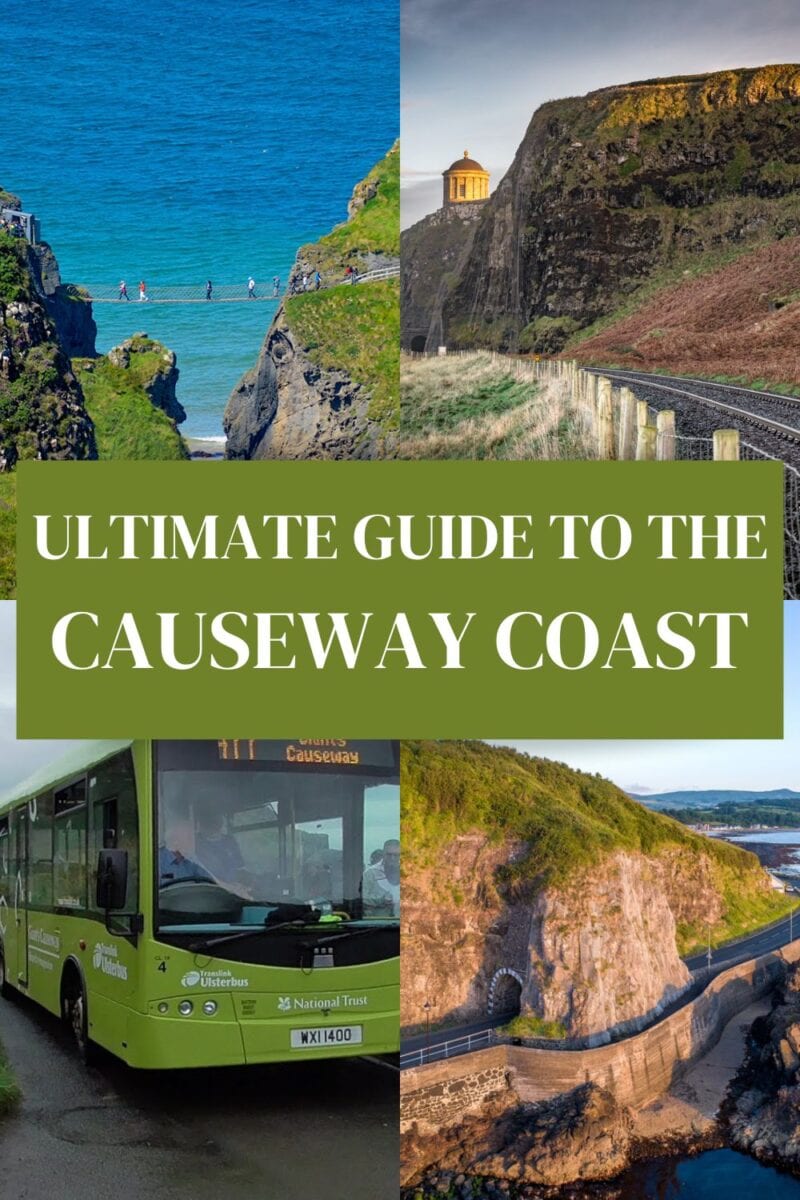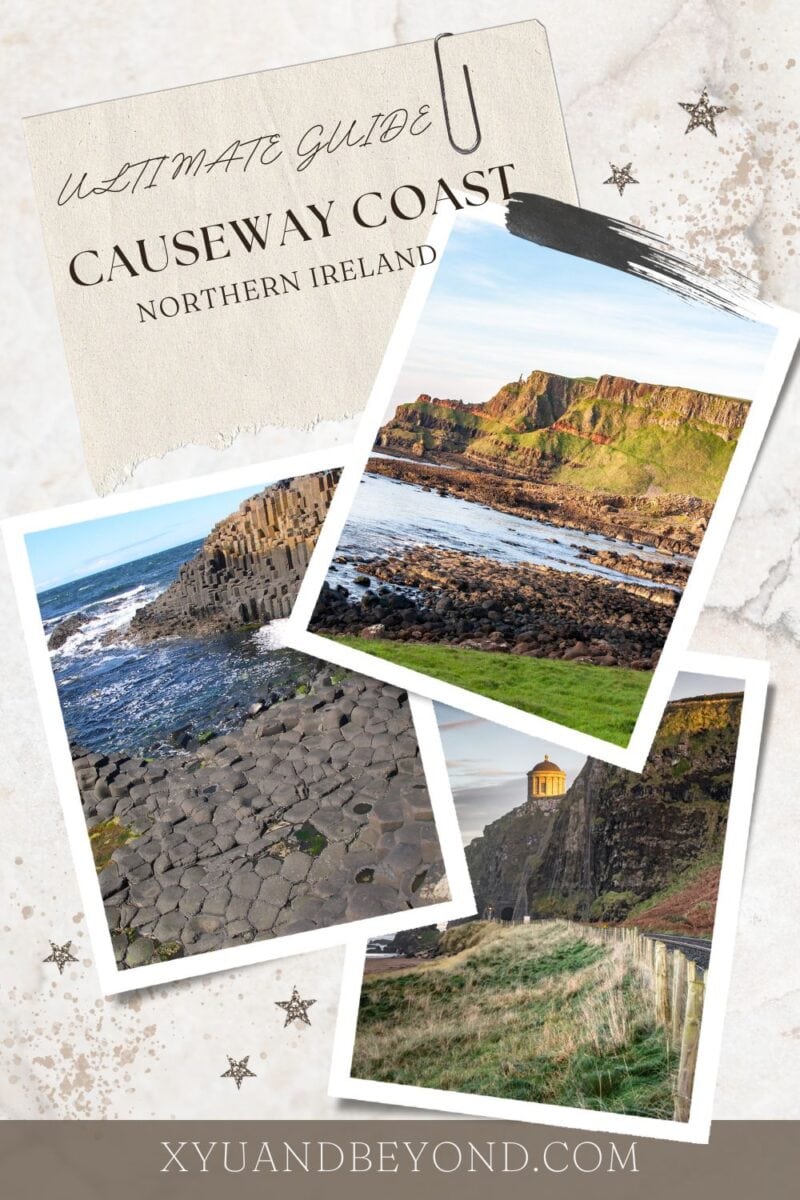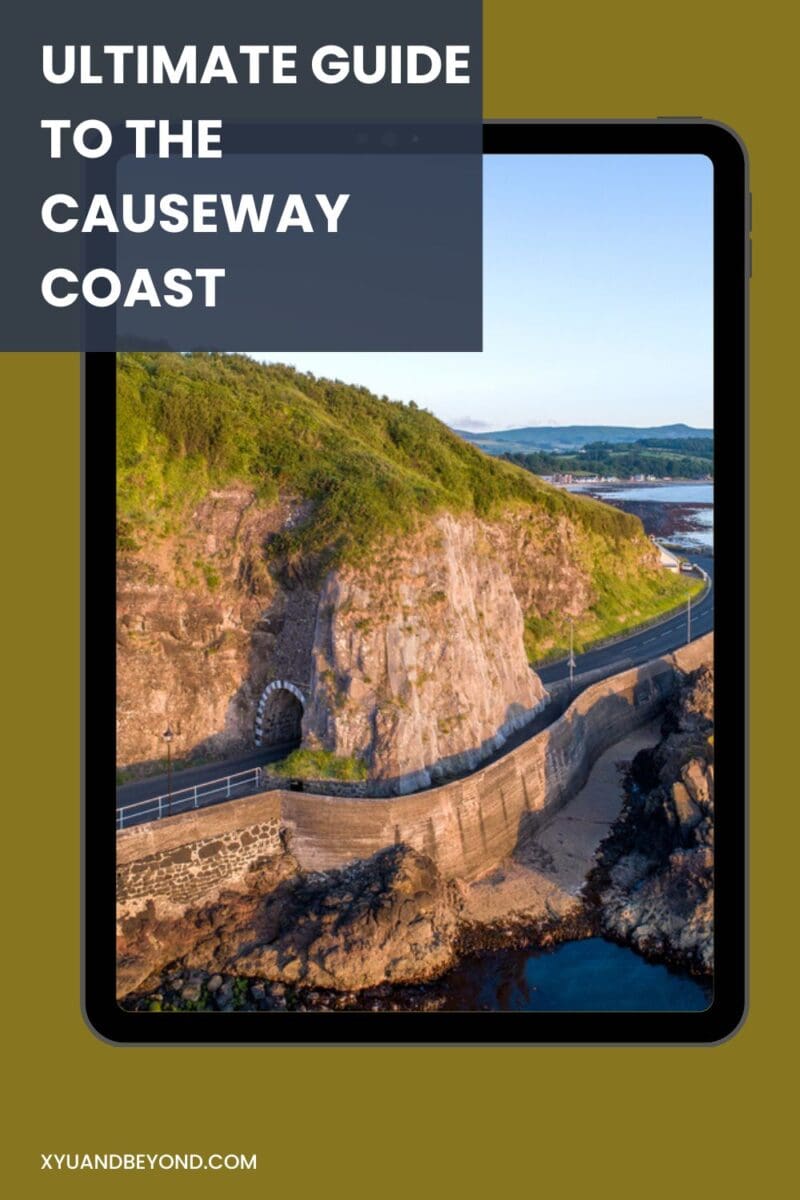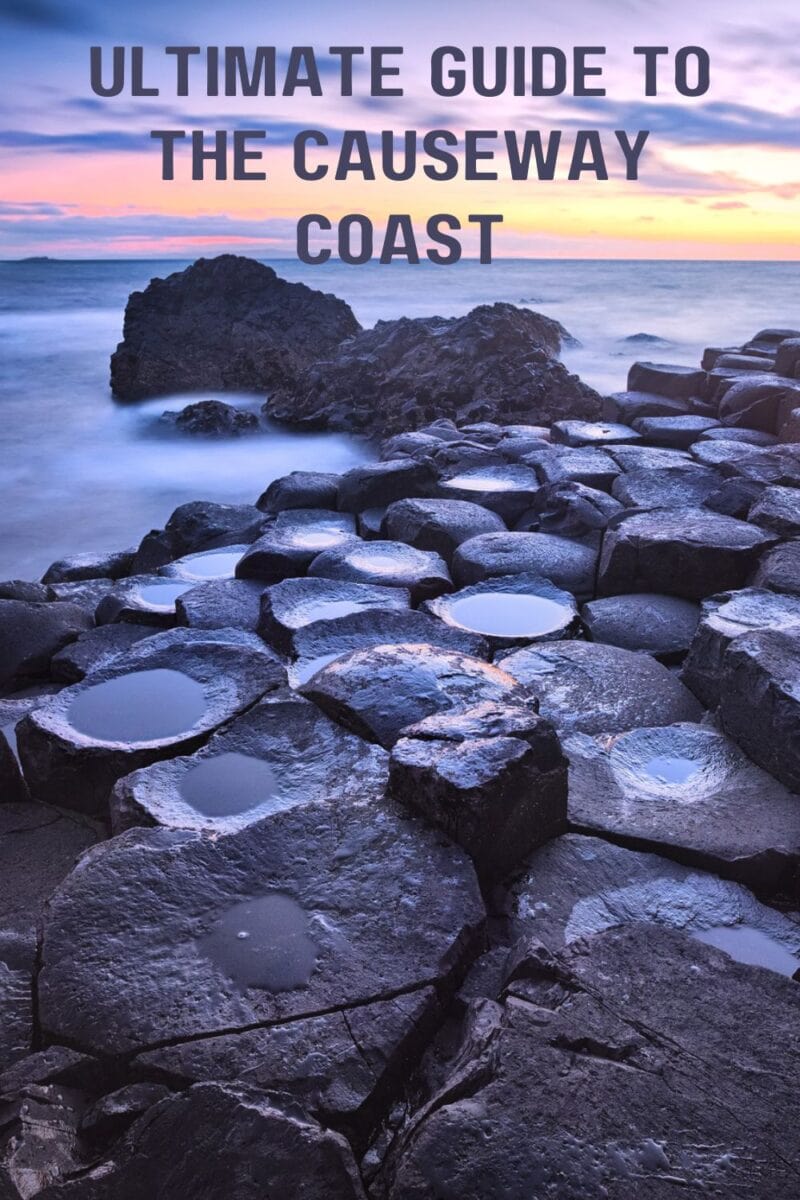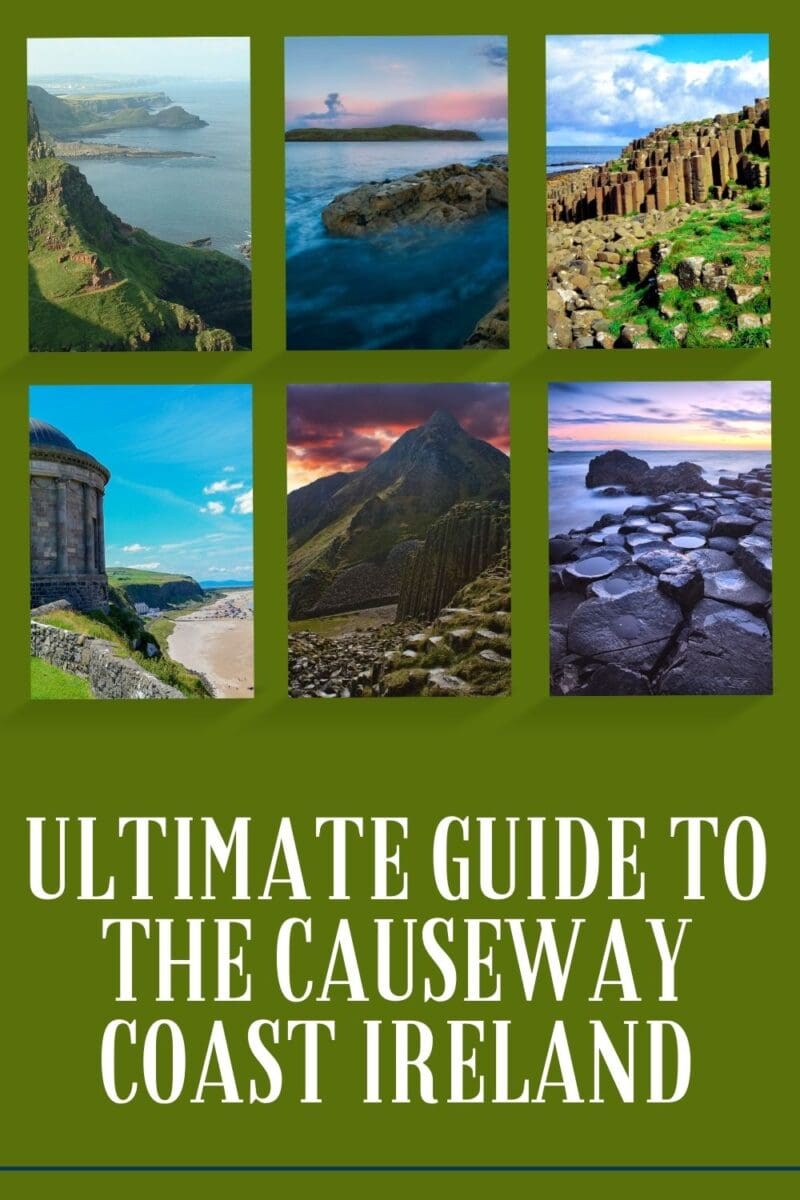How to plan your Causeway Coastal Route Northern Ireland
Driving the Causeway Coast Route in Northern Ireland on the Antrim coast road is a bucket list dream come true. This Causeway Coast Itinerary will make a poet out of almost everyone, the scenery is jaw-droppingly beautiful and it will imprint this part of Ireland on your heart forever.
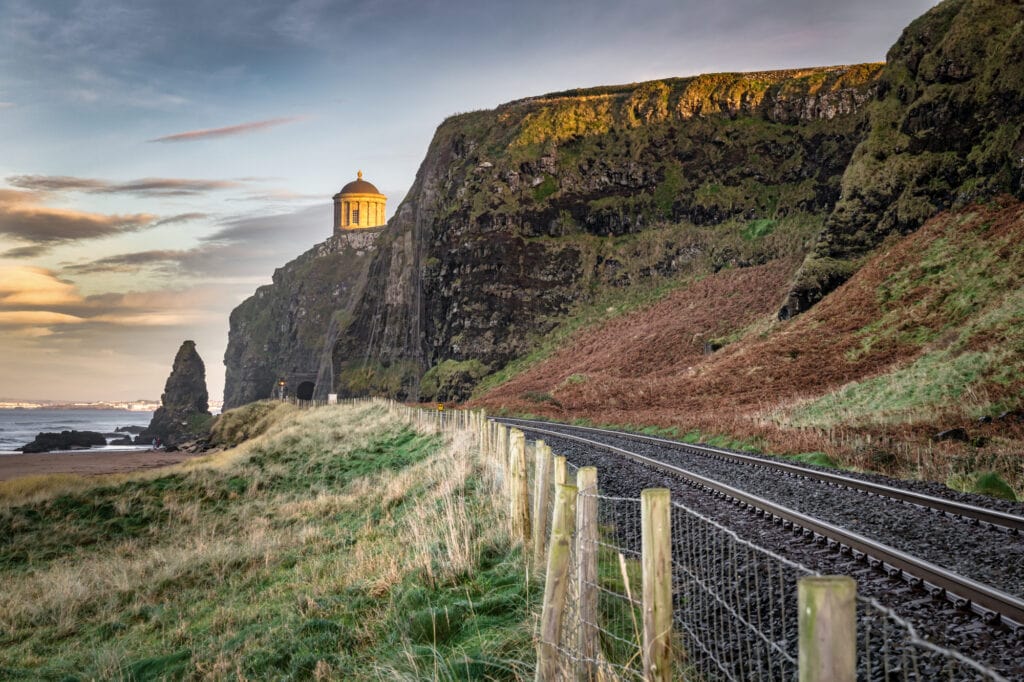
From the Nine Glens of Antrim through to the views of Donegal the Antrim coastal road is simply one of the most scenic drives in the world. You may not be aware of it but Ireland has some absolutely beautiful beaches and the Northern Ireland beaches are no exception. From miles of sandy beaches that stretch forever to rockier shores and sands making for long walks Northern Ireland’s beaches are truly some of the best on the Island.
This Causeway coast route highlight includes 31 spots to stop and see along the North Antrim coast drive. Below are some of my favorite stops on the Causeway Coastal Route so you can create your itinerary to match your preferences.
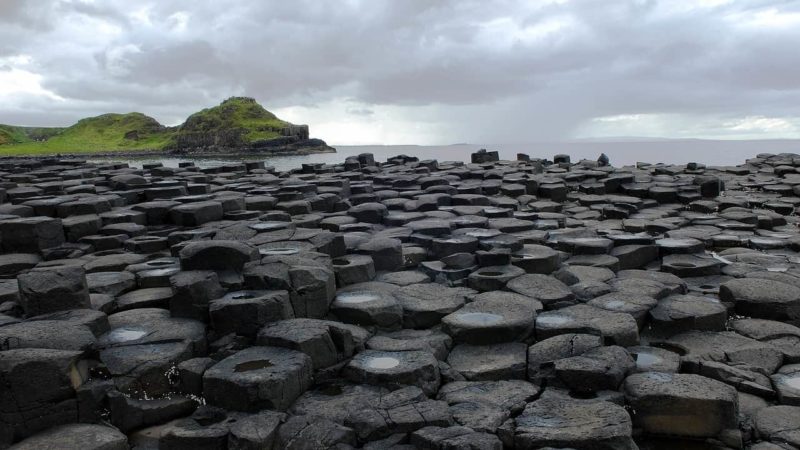
- How to plan your Causeway Coastal Route Northern Ireland
- Frequently Asked Questions: How to Plan Your Causeway Coastal Route Northern Ireland
- What is the Causeway Coastal Route?
- How can I plan my itinerary for the Causeway Coastal Route?
- How long does it take to drive the Causeway coastal route?
- How far is the Causeway Coastal Route from Belfast?
- What are some must-see attractions along the Causeway Coastal Route?
- Is it worth taking a guided tour along the Causeway Coastal Route?
- How long does it take to complete the Causeway Coastal Route?
- What are some recommended stops along the Causeway Coastal Route?
- How long is the coastal Causeway Route?
- How long does the Causeway Coastal Route take?
- Can I drive the Causeway Coastal Route?
- Can I do the Causeway coastal route without a car?
- Causeway Coastal Route Map
- Causeway Coast Way Buses
- 31 Stops on the Causeway Coastal Route
- Carrickfergus
- Whitehead
- 9 Glens of Antrim
- Islandmagee
- The Gobbins Walk
- Larne
- Cairndhu Castle and the Madman's Window
- Glenarm
- Glenarm Castle
- Slemish Mountain
- Carnlough
- Waterfoot and the Nine Glens of Antrim
- Glenariff Forest Park
- Cushendall
- Cushendun
- Fairy Hill of Tiveragh
- Fair Head
- Torr Head Scenic Route
- Ballycastle
- Bonamargy Friary
- Rathlin Island
- Bushmills Distillery and Village
- Carrick-a-Rede Rope Bridge
- Dark Hedges
- Ballintoy
- The Giant's Causeway
- Visiting Dunluce Castle
- Portrush
- Portstewart
- Benone
- Castlerock
- Binevenagh Mountain
- Mussenden Temple & Downhill Demesne
- Derry (Londonderry)
- Where to stay on Causeway Coastal Route
- Frequently Asked Questions: How to Plan Your Causeway Coastal Route Northern Ireland
In compliance with the FTC guidelines, please assume the following about all links, posts, photos and other material on this website: Any/all of the links on this website are affiliate links of which xyuandbeyond receives a small commission from sales of certain items, but the price is the same for you.
Planning a trip to Ireland? Everything you need to know
Frequently Asked Questions: How to Plan Your Causeway Coastal Route Northern Ireland
What is the Causeway Coastal Route?
The Causeway Coastal Route is a scenic drive along the northern coast of Ireland, showcasing stunning landscapes, historical sites, and charming villages.
How can I plan my itinerary for the Causeway Coastal Route?
To plan your Causeway Coastal Route itinerary, start by researching popular attractions along the causeway such as castles, beaches, and cliffs. Create a list of stops you want to visit and map out your route accordingly.
How long does it take to drive the Causeway coastal route?
The route itself is 120 miles of stunning coastal beauty and a contender for ‘World’s Greatest Road Journey’.
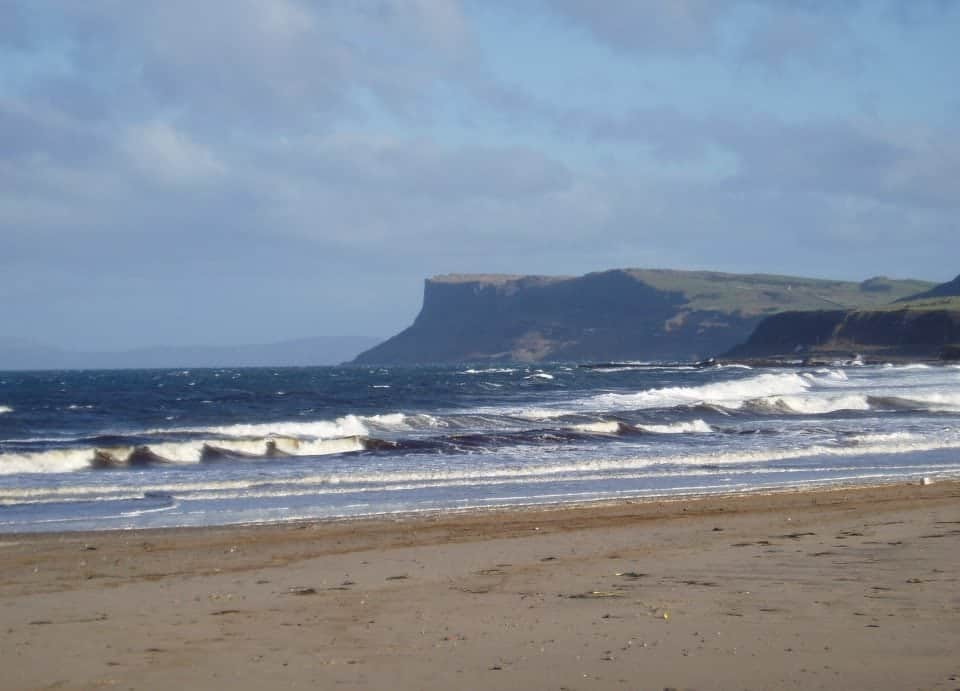
How far is the Causeway Coastal Route from Belfast?
The distance between Belfast City and Giant’s Causeway is 61 miles.
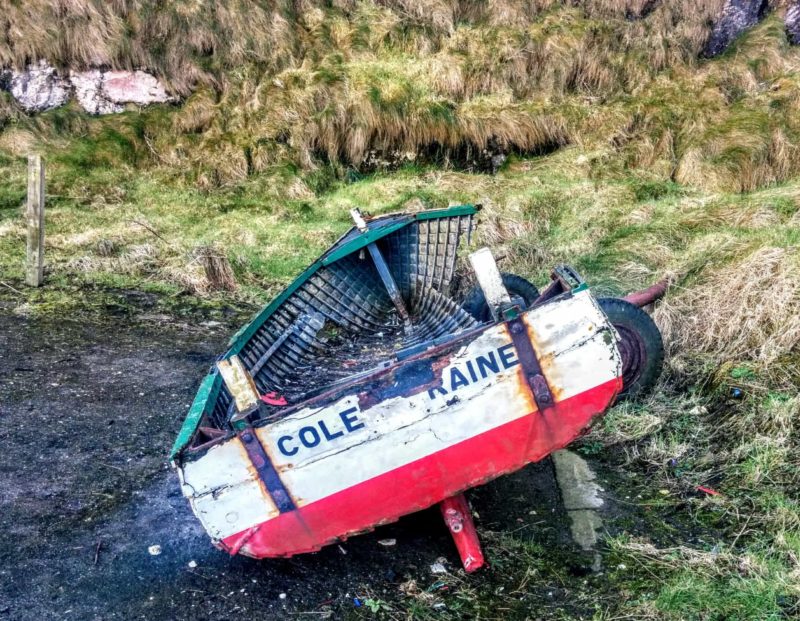
What are some must-see attractions along the Causeway Coastal Route?
Some must-see attractions along the Causeway Coastal Route include Dunluce Castle, the Giant’s Causeway, Carrick-a-Rede Rope Bridge, and the Dark Hedges – a popular Game of Thrones filming location. Some must-see attractions along the Causeway Coastal Route include Dunluce Castle, the Giant’s Causeway, Carrick-a-Rede Rope Bridge, and the Dark Hedges – a popular Game of Thrones filming location. There is also Mussenden Temple and Downhill Demense the Glenariff Forest Park and the Giant’s Causeway along the Antrim Coast.
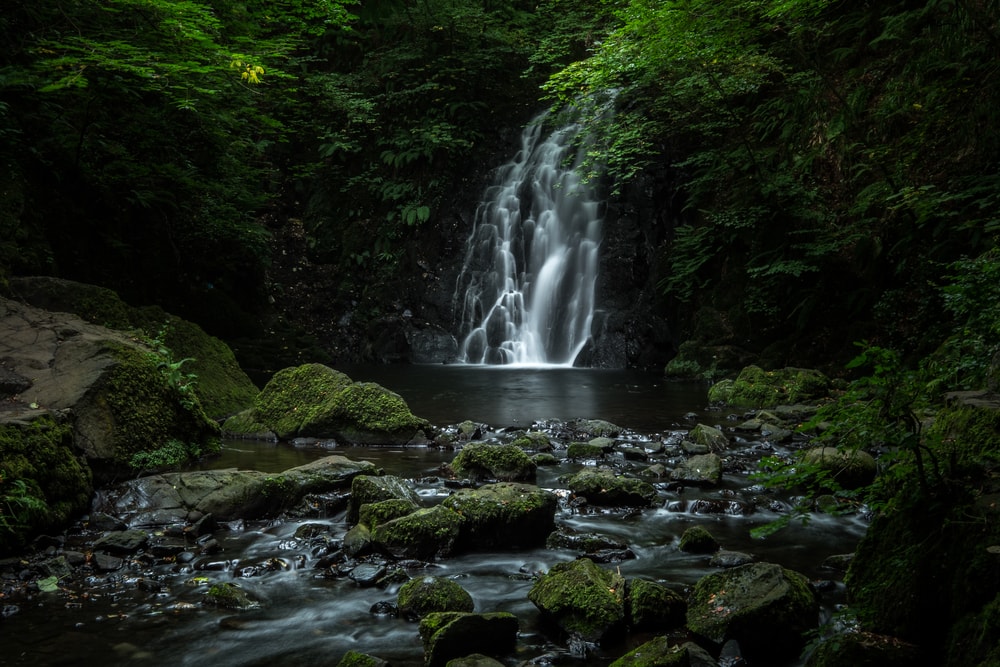
Is it worth taking a guided tour along the Causeway Coastal Route?
For a hassle-free experience, consider taking a guided tour of the Causeway Coastal Route to ensure you don’t miss any highlights and learn about the history and culture of the region.
How long does it take to complete the Causeway Coastal Route?
The duration of the Causeway Coastal Route can vary depending on how many stops you make and how much time you spend at each attraction. A typical drive without stops takes around 2-3 hours, but it’s recommended to allow at least a full day to fully enjoy the route.
What are some recommended stops along the Causeway Coastal Route?
Some recommended stops along the Causeway Coastal Route include Bushmills (home to the Bushmills Distillery), Ballycastle with the Bonamurgy Friary ruins and the Black Nuns gravestone, Fairhead and Tor Head, Mussenden Temple and Downhill Demesne perched on the sea’s edge where the views are outstanding and much more.
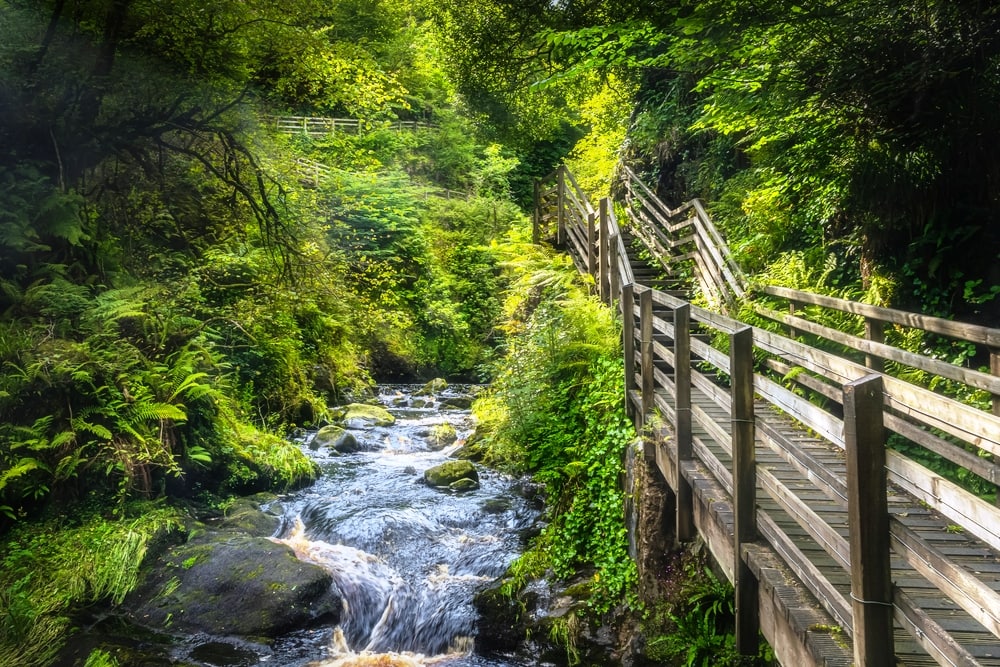
How long is the coastal Causeway Route?
This Causeway coastal route itinerary covers around 120 miles or 190 km of the North Coast of Northern Ireland. The coastal Causeway route begins in Belfast and ends in Derry (London/Derry)
101 Landmarks in Northern Ireland
Essential guide to renting a car in Ireland
How long does the Causeway Coastal Route take?
To drive the entire 313km/195-mile route, you’ll need 3-5 days to give yourself enough time to really appreciate this coastal route itinerary.
Can I drive the Causeway Coastal Route?
When planning your Giant’s Causeway Itinerary this coastal causeway route assumes that you will be driving from Belfast. There is no way to see all the coastal causeway route on a tour. Most of the tours will only stop at a few locations and the best way is to rent a car and drive the route beginning in Belfast.
Can I do the Causeway coastal route without a car?
If you travel between May and September the Antrim Coaster and Causeway Rambler buses cover the area. The Antrim Coaster takes the scenic route from Belfast to the Causeway area with stops en route. The Causeway Rambler covers the area from Coleraine to Ballycastle so will take you to places like Dunluce Castle, Bushmills, Carrick-a-rede, etc etc.
Causeway Coastal Route Map
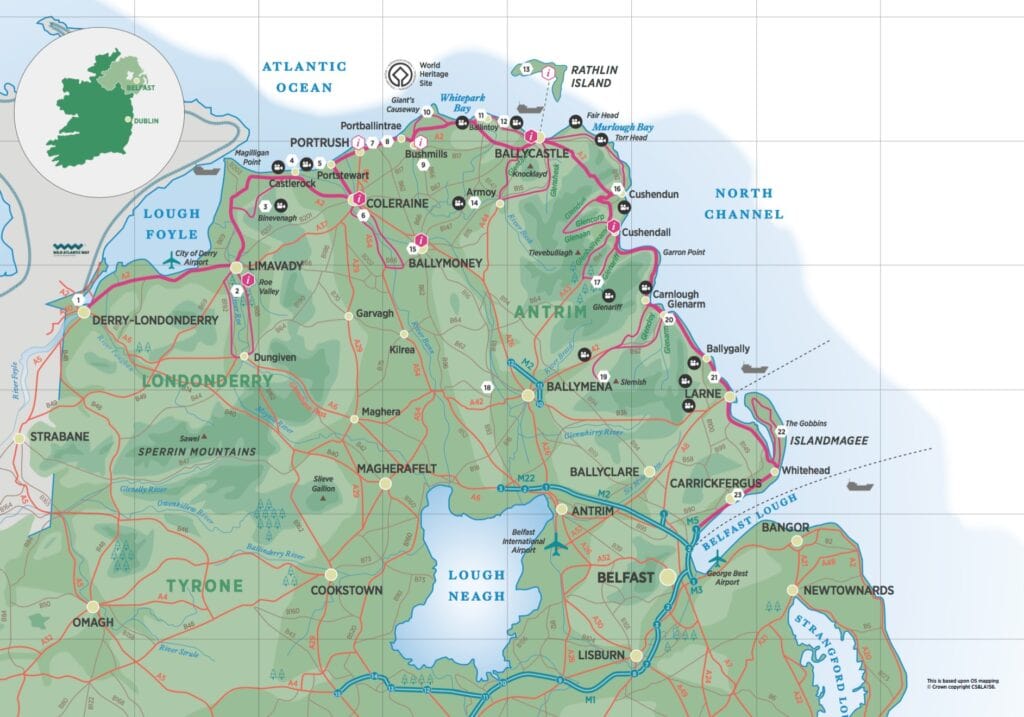
Many of these stops were and are being used in the HBO Game of Thrones series. When you travel the route, you will see small plaques with the information as to what scene was filmed in that location. You can if you want do your very own self-guided GOT tour or take one of the many tours out of Belfast or Dublin.
Causeway Coast Way Buses
Ulsterbus 177
Terminus: Giant’s Causeway – Coleraine.
Serving: Giant’s Causeway – Bushmills – Portballintrae – Dunluce Castle – Portrush – Portstewart.
Frequency: 4 buses daily. Operates: Jul – Aug.
Antrim coaster service 252
Terminus: Belfast – Coleraine.
Serving: Belfast – Larne – Ballycastle – Ballintoy – Giant’s Causeway – Bushmills – Portballintrae – Portrush – Portstewart – Coleraine.
Frequency: 2 bus daily. Operates: May-Sep.
Ulsterbus Causeway rambler 402
Terminus: Carrick-a-Rede – Coleraine.
Serving: Carrick-a-Rede – Ballintoy – White Park Bay – Dunseverick Castle – Giant’s Causeway – Bushmills – Dunluce Castle – Portrush.
Frequency: 7 buses daily. Operates: Jun-Sep.
From Belfast head east to Carrickfergus, this is about a 26-minute, drive. The biggest draw in Carrickfergus (and there are quite a few) is the castle.
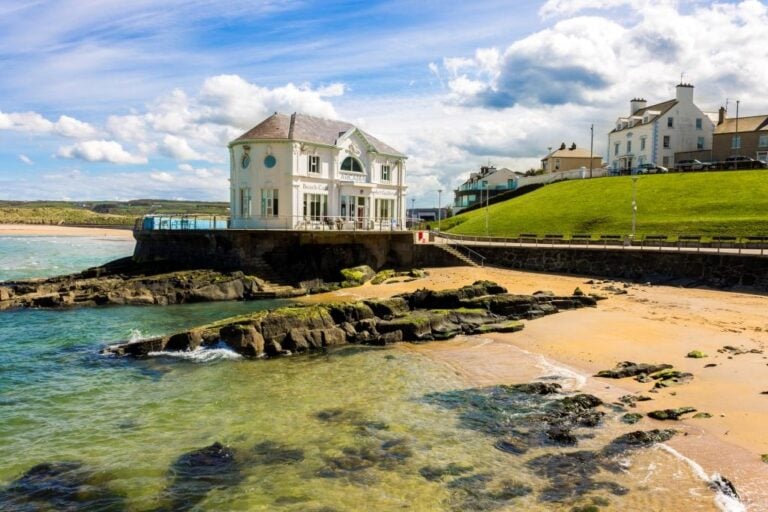
31 Stops on the Causeway Coastal Route
If you are planning your Causeway Coastal route itinerary you can drive and see most of the attractions in one day. However if you really want to explore this incredible part of Northern Ireland you should plan on taking a few days to really enjoy the journey.
Carrickfergus
On the east coast of Northern Ireland from Belfast is Carrickfergus Castle a Norman Castle Built by the Anglo-Norman John de Courcy over 800 years ago. The castle sits on the edge of the water looking out over the bay and protecting the harbour to this day. Don’t forget to look for the ghost.
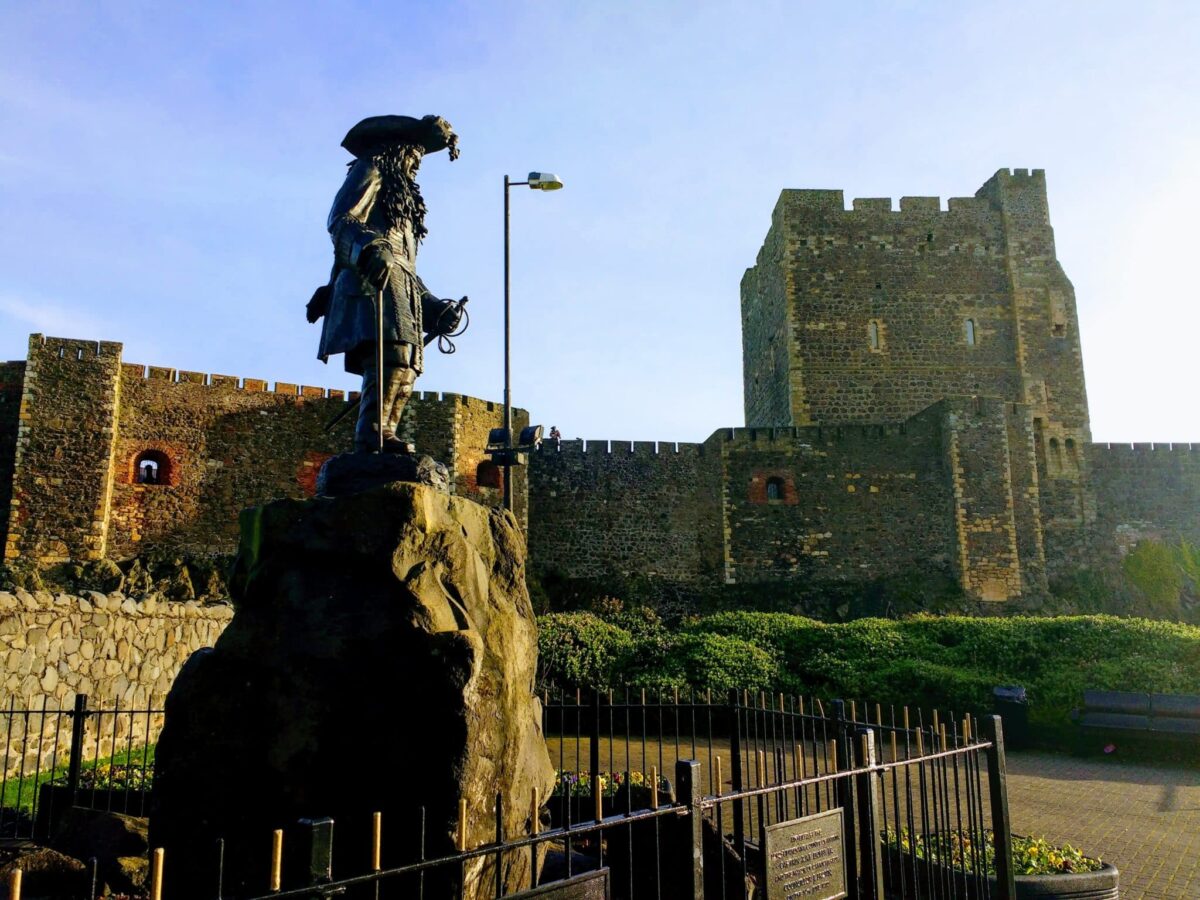
The castle has several historical displays and houses cannons from the 17th through 19th centuries. The Castle is open to visitors year-round but checks the website as the winter hours do differ. The cost for entry into the castle is €5.50 per adult and €3.50 for children and seniors.
This is a fabulous Walking Tour Guide from the Mid and East Antrim Borough Council that will come in very handy if you want to spend more time in Carrickfergus and learn about the history of the area.
Whitehead
From Carrickfergus, the trip down the coast to Whitehead is around 30 minutes or less but it passes through some incredibly scenic roads. Whitehead is a really pretty Irish seaside town. Its history goes back to the 1600s when a small village grew up around Chichester Castle, the ruins of which can be seen on Chester Avenue.
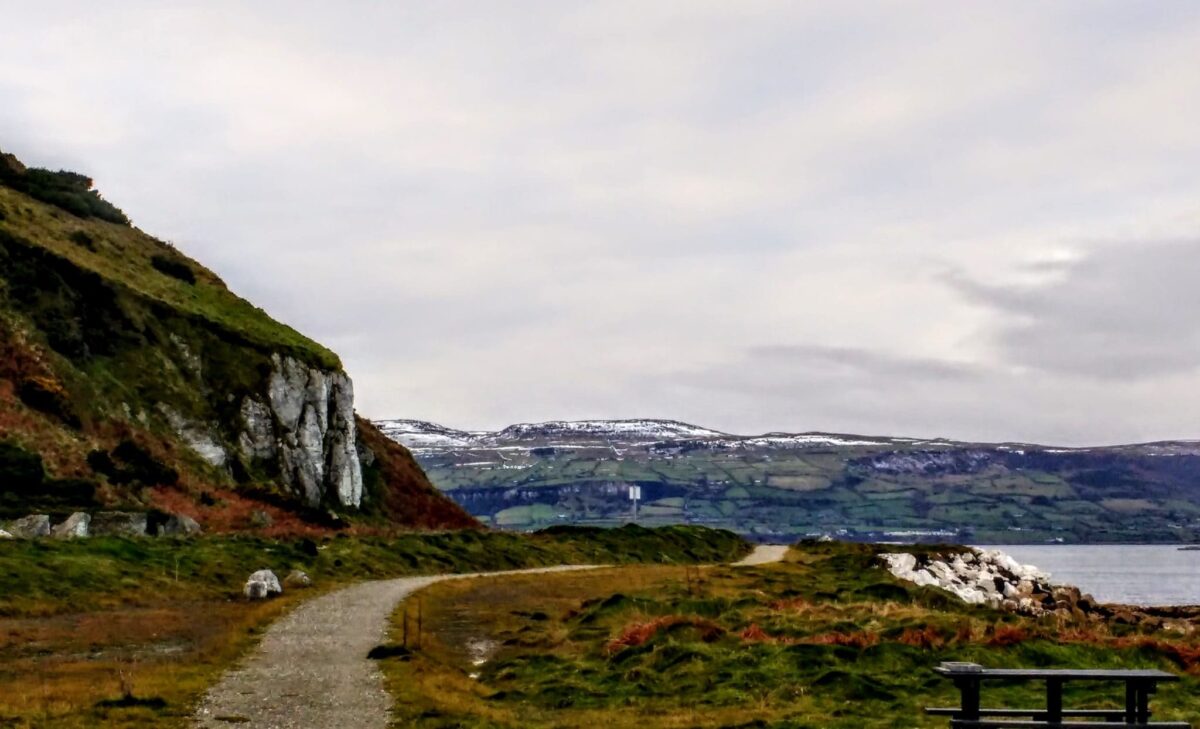
Because it was a good port for shipping from Scotland, the village grew and when the railway arrived in the mid-1800s a suburb of Belfast was born. Folks moved out to Whitehead because transportation into the city was now easy. With the railway the village became an easy visit for day-trippers and holidaymakers, a seaside promenade was built, and with its cafes, restaurants and walking trails.
9 Glens of Antrim
Plan on stopping and seeing the 9 Glens of Antrim on this tour of the Causeway Coastal Route, the route lies at the foot of the Glens which have been declared an Area of Outstanding Natural Beauty.
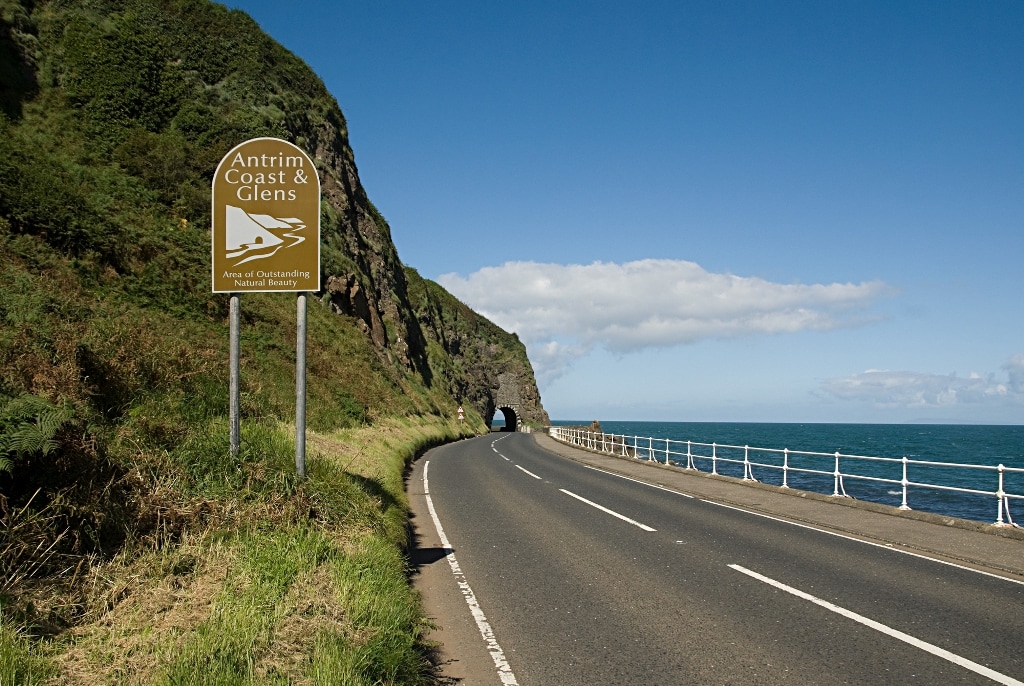
The 9 Antrim Glens are Glentaisie, Glenshesk, Glendun, Glanaan, Glenballyemon, Glencorp, Glenariff, Glencloy and Glenarm. There are stunning walks, roaring waterfalls, dense forests and hikes that go on forever. Driving through the Glens will take your breath away.
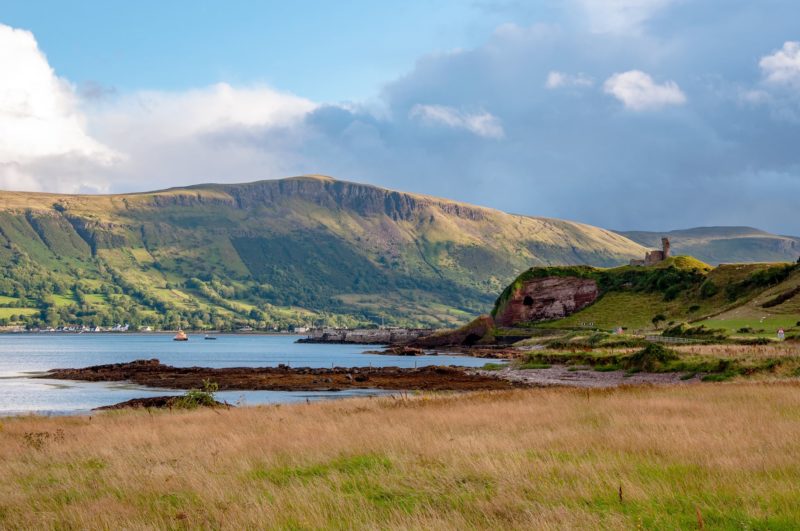
Islandmagee
From Whitehead to Islandmagee is around a 10-minute drive. Islandmagee is not exactly an island but a peninsula, which is a simply beautiful place for a day out for a picnic and bird watching or hiking.
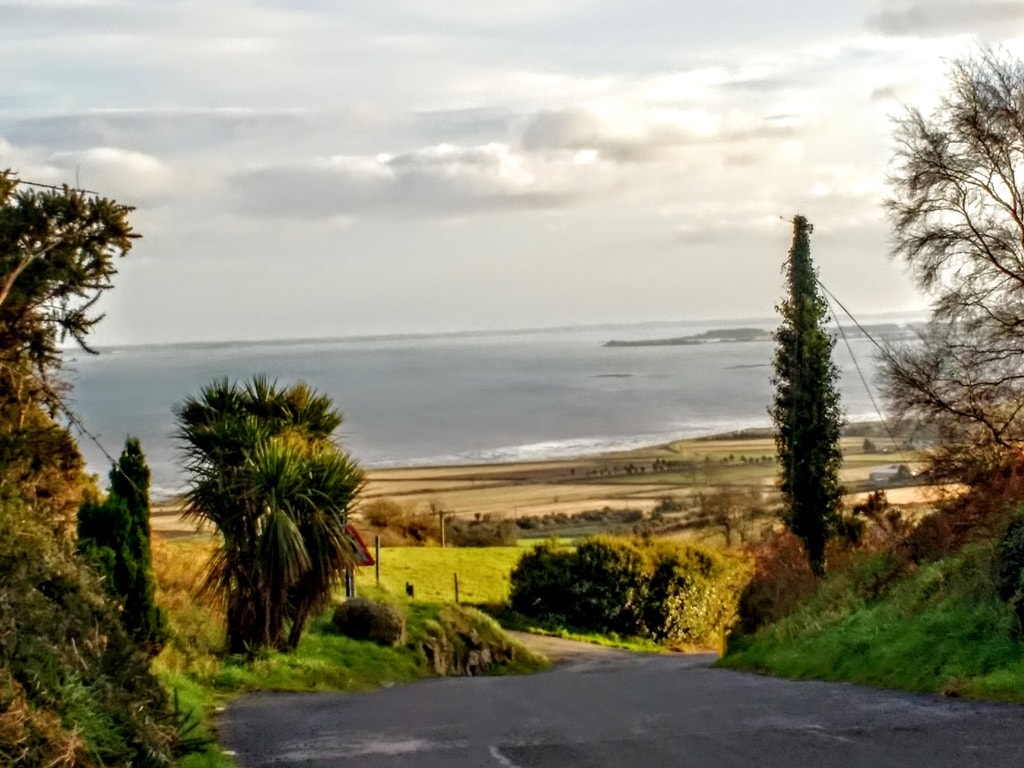
The people from Belfast know the area mostly for the lovely beach of Brown’s Bay. If a beach is what you are after but you want something quieter, just drive around the northern side of the peninsula and there are several small ones nestled between the rugged rocky promontories. Portmuck is a good option. On the southern side, the coastline is gentler but the waters of Larne Lough aren’t ideal for swimming.
The Gobbins Walk
Islandmagee is also, where you will find the world-famous Gobbins Walk along the limestone cliffs, which range for 3-4 miles along the eastern coast. The Gobbins walk must be booked ahead of time and will take around 4 hours.
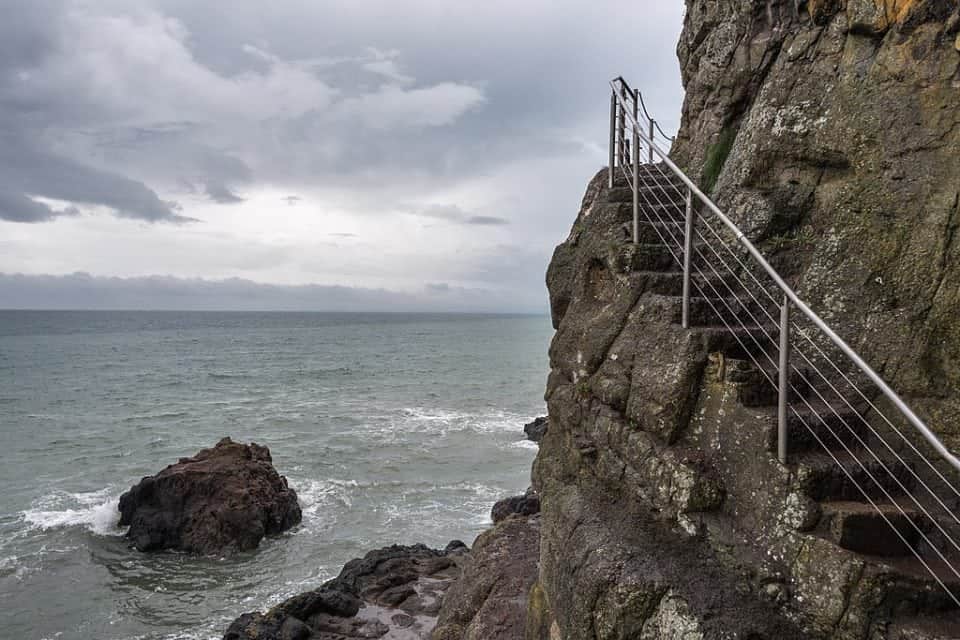
Larne
Larne, which is around 10 minutes from Islandmagee, is rather undiscovered by tourists but is full of history dating back thousands of years. You can see a standing stone, have a look at the Armada Tree, which is said to date back to the 16th century and grown from seeds in a Spanish sailor’s pocket.
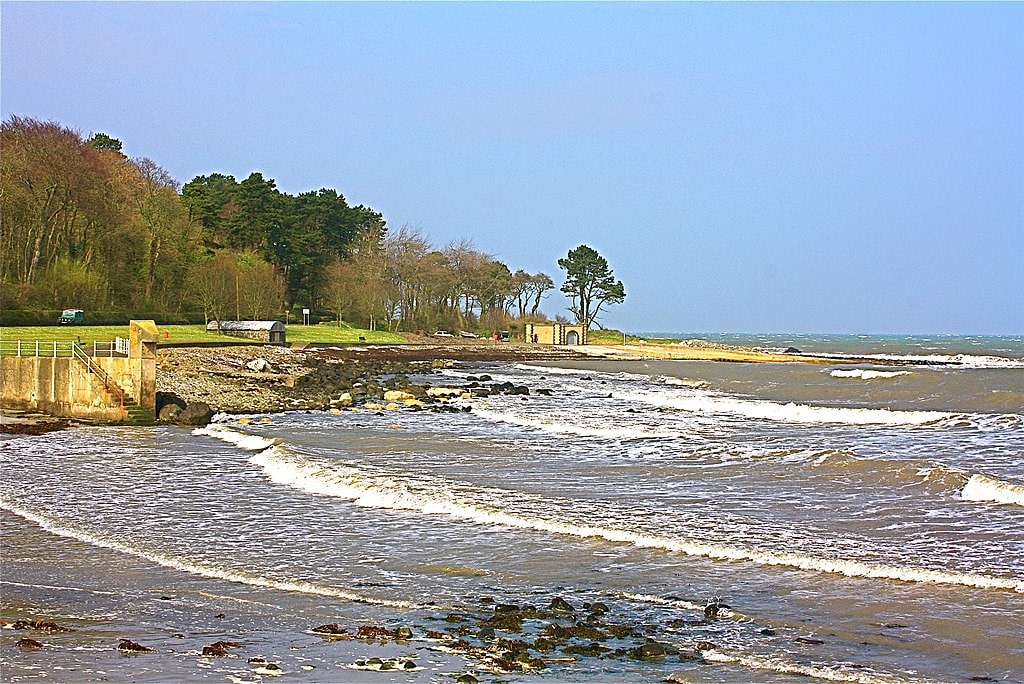
Cairndhu Castle and the Madman’s Window
Take a look at the Cairndhu Castle ruins and if you are in the mood for a walk take a small stroll to the north of Larne along the Glenarm Coastal Path to see the Madman’s Window. These are two large limestone boulders that have naturally created a window-shaped gap in the rock that looks towards the Irish Sea.
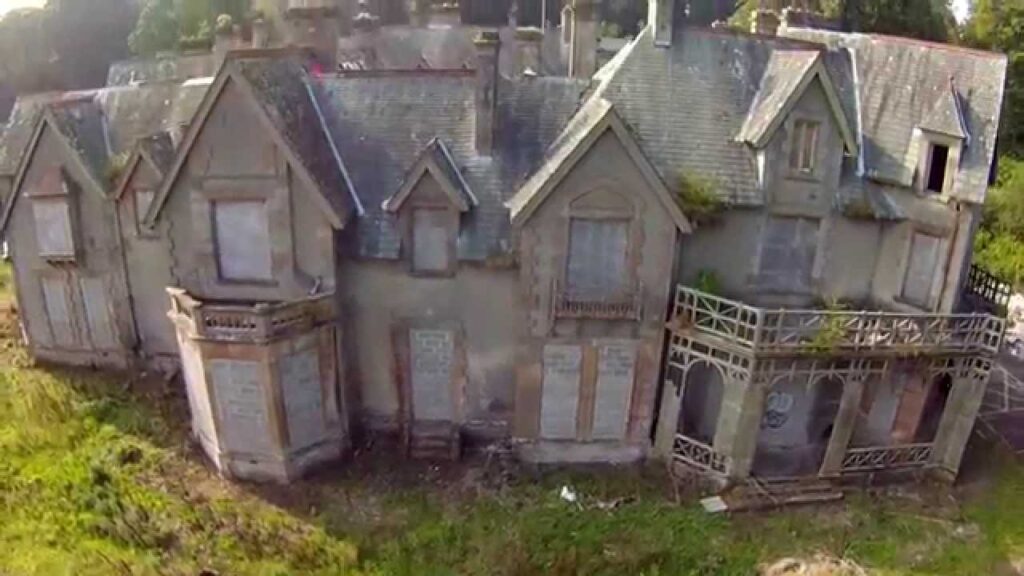
Glenarm
Glenarm is literally a walk from Larne (admittedly a long one) and only a 20-minute drive. Glenarm is the perfect place to spend the night and rest up after your Gobbins Walk.
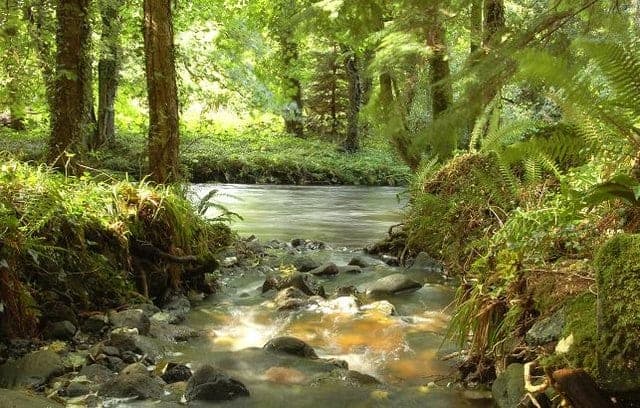
Glenarm is the first of the 9 Glens of Antrim and is a picturesque little village with lots to offer. There are Georgian streets, which date back to the 17th century, and it is one of the oldest villages on the Causeway Coast Route. There are Red squirrel and Sculpture trails at Glenarm Forest that the kids will love. Pay a visit to the beautiful castle at Glenarm and although this is a private home, you can walk through the gorgeous walled garden and have a light lunch in the Cafe.
Glenarm Castle
Glenarm Castle is where the McDonnell Family moved to when they left Dunluce. The Barbican, which is the old entrance to the Castle, is available as a B&B and makes a perfect romantic getaway.
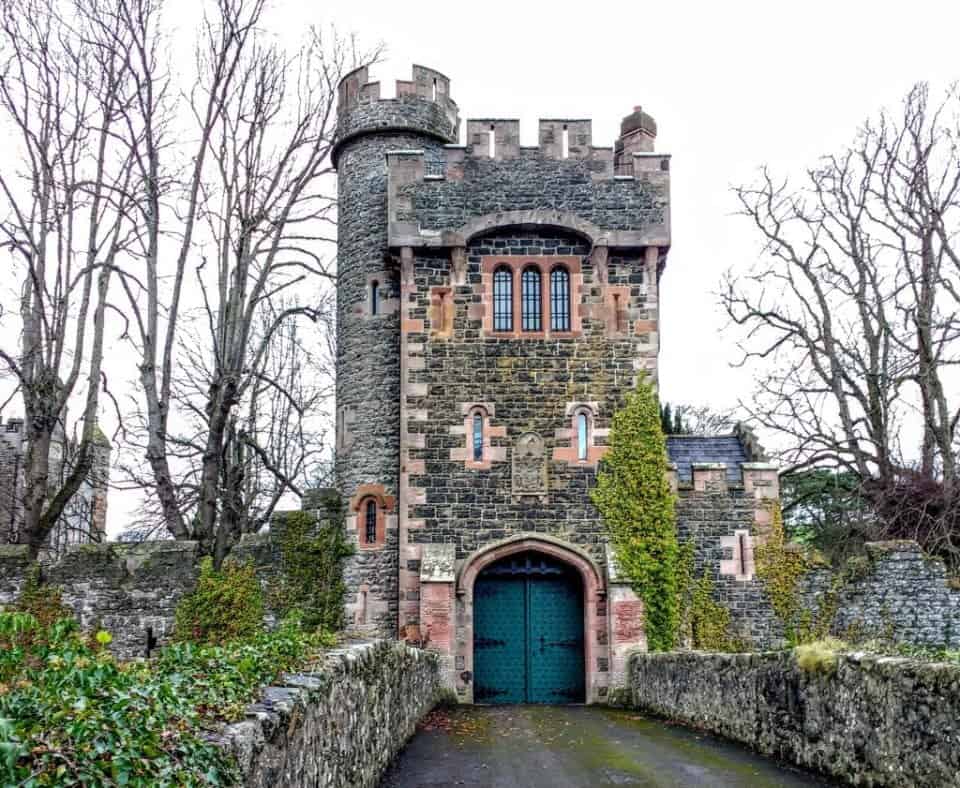
Slemish Mountain
If you are a hiker and walking fanatic then you will want to do the Glenarm to Slemish Mountain Walk. This is a 22-mile walk/hike that takes you up to Slemish.
Slemish is the area that St. Patrick was brought to as a slave when he was captured. The Slemish Mountain, which can be seen from several areas on the Causeway Coastal Route, is the remnant of an old volcano that over the centuries has become flattened by glaciers and time.
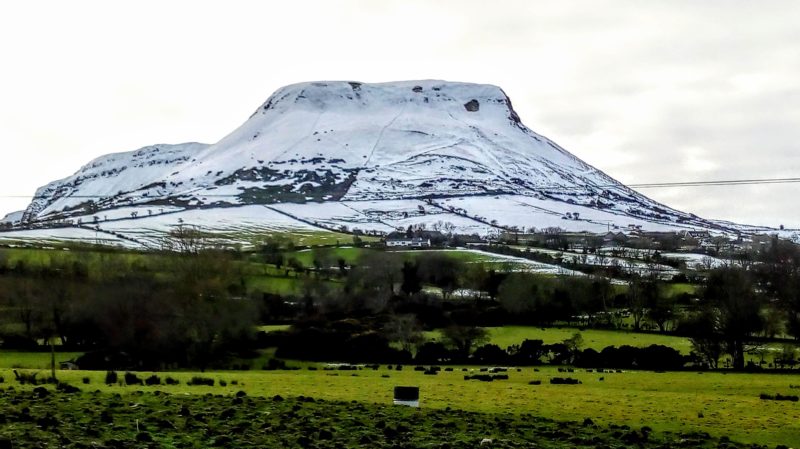
The route up Slemish is around 1430 feet and there is a car park at the base from which you can climb the Mountain. It is a hard climb but the views are spectacular.
Carnlough
After a vigorous climb up Slemish Mountain, you will head onto Carnlough probably for a meal and a rest. Carnlough is around a 20-minute drive from the Mountain.
Carnlough lays at the foot or mouth of Glencloy another of the 9 Antrim Glens. Carnlough has a beautiful harbour built by the Marchioness of Londonderry who inherited the estate.
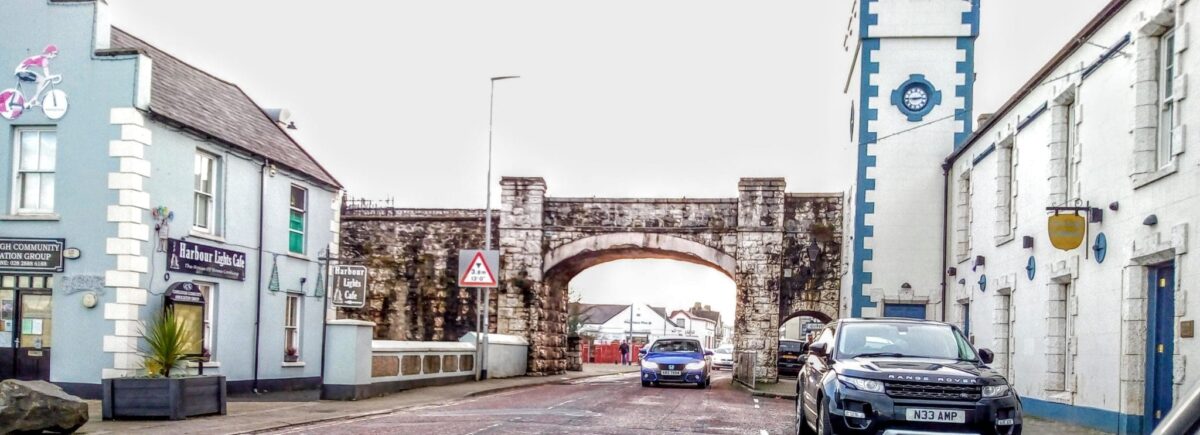
Take some time here to either stay over at the Londonderry Arms right across from the Harbour the Marchioness built. The Arms was a coaching house and Winston Churchill owned the hotel from 1821-1924. Churchill inherited the estate from the family.
A must-do walk when in Carnlough is Cranny Falls a beautiful waterfall set in a gorge in an Area of Outstanding Natural Beauty. The walk is around km each way and it is signposted with interpretation panels along the route.
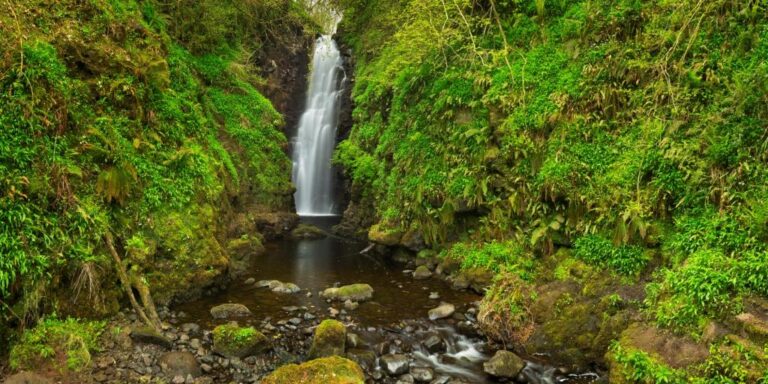
Waterfoot and the Nine Glens of Antrim
Continuing along the Causeway Coast Route for around 18 minutes you will come to Waterfoot. Right on the Coast Waterfoot has a beautiful red sand beach and the small village sits at the foot of Glenariff the Queen of the Glens.
Just outside Waterfoot on the coast road is the White Lady, a chalk figure carved by the sea washing against the cliffs. If you are in Waterfoot in July, don’t forget to check out the famous Glens of Antrim Féis. This is a Gaelic Celebration including arts, crafts, ancient sports, music, dance singing feasting and more.
Glenariff Forest Park
If you have the hiking bug take a walk through the Glenariff Forest Park where you can see 3 spectacular waterfalls and ancient woodlands that will give you pagan thoughts and dreams.
The Magnificent Game of Thrones Tapestry Belfast
10 Game of Thrones Doors Northern Ireland to visit
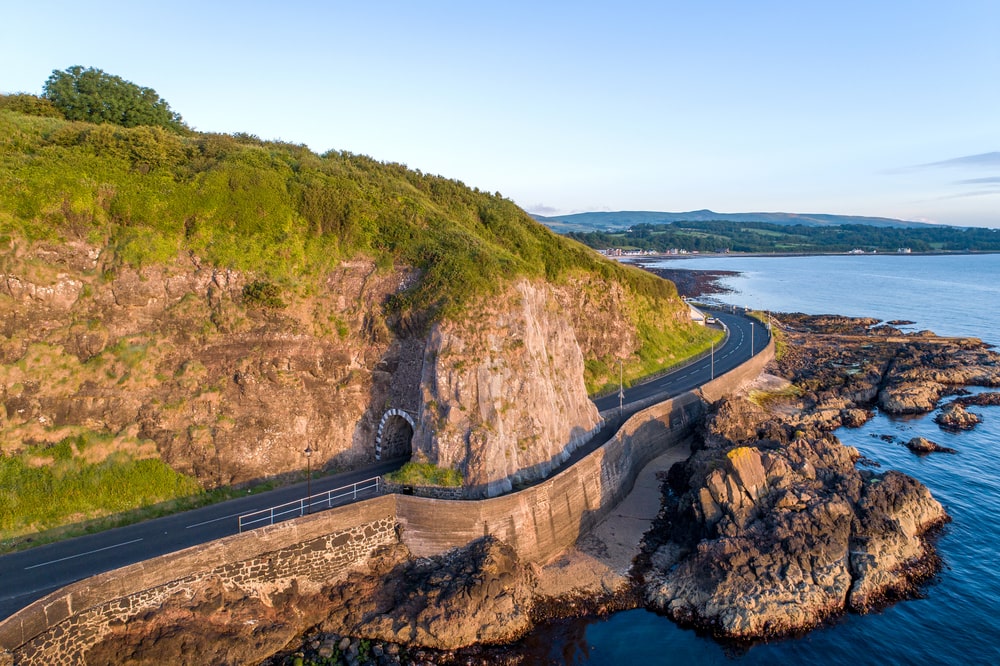
Cushendall
Cushendall is a 5-minute drive from Waterfoot Cushendall is sometimes called the “heart of the Glens” and it was the first place in Ireland to be electrified thanks to its wealth of waterfalls. Cushendall is also, where the coast road was widened years ago and you will see the Red Arch that sits below Red Bay Castle.
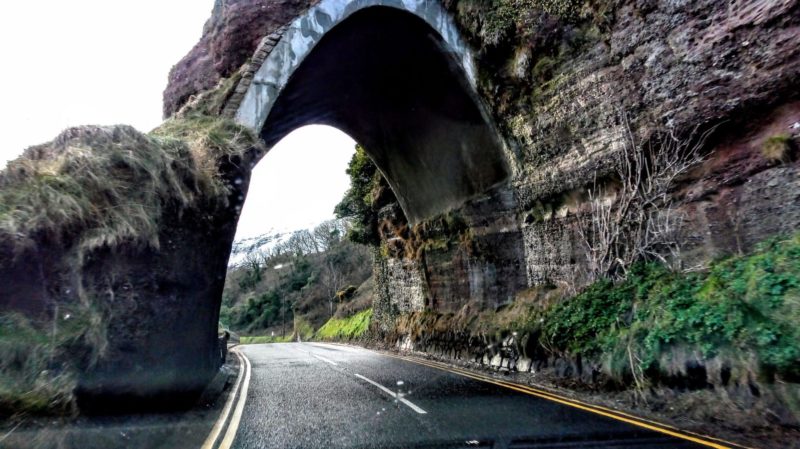
If you are in the area in August, why not attend the “Heart of the Glens Festival” that takes place over 10 days and incorporates virtually every Irish tradition going.
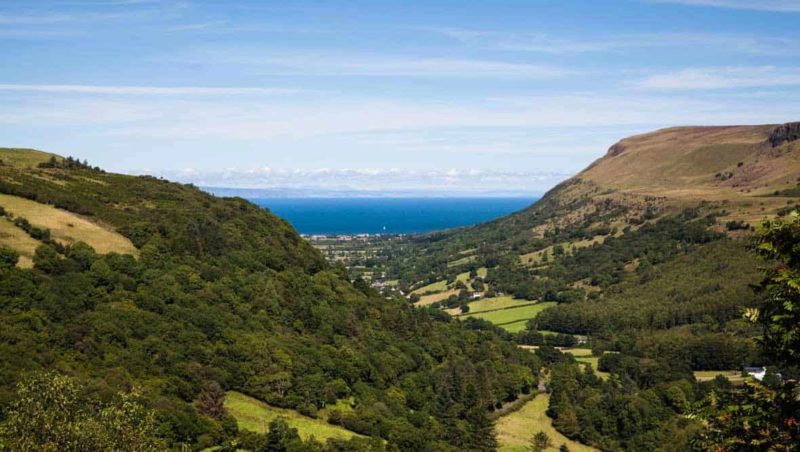
Cushendun
Cushendun at the foot of Glendun and Glencorp was the perfect landing spot for the Clans as they fled to Ireland. The beach stretches for miles fed from the glacial streams of the mountainous glens. Cushendun sits at the summits of Lurigethan and Tievebulliagh where the Fairies are said to hide inside. These mountains and adjacent glens are scattered with the traces and remains of man’s existence since Neolithic times.
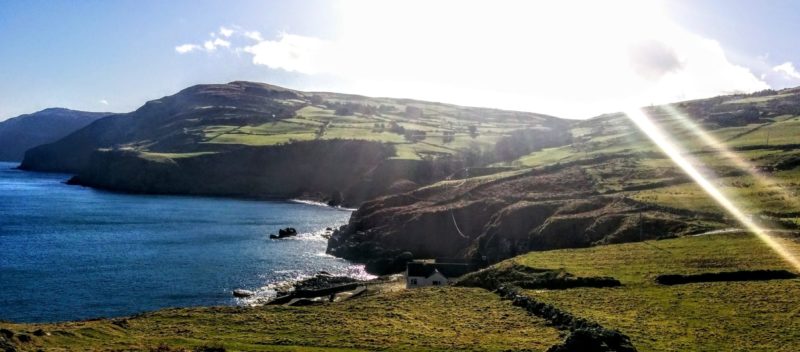
They are also scattered with Game of Thrones filming sites and Cushendun is one of the most popular so you will see many tour buses pulling up. Get there early and you can have Melisandre’s caves all to yourself.
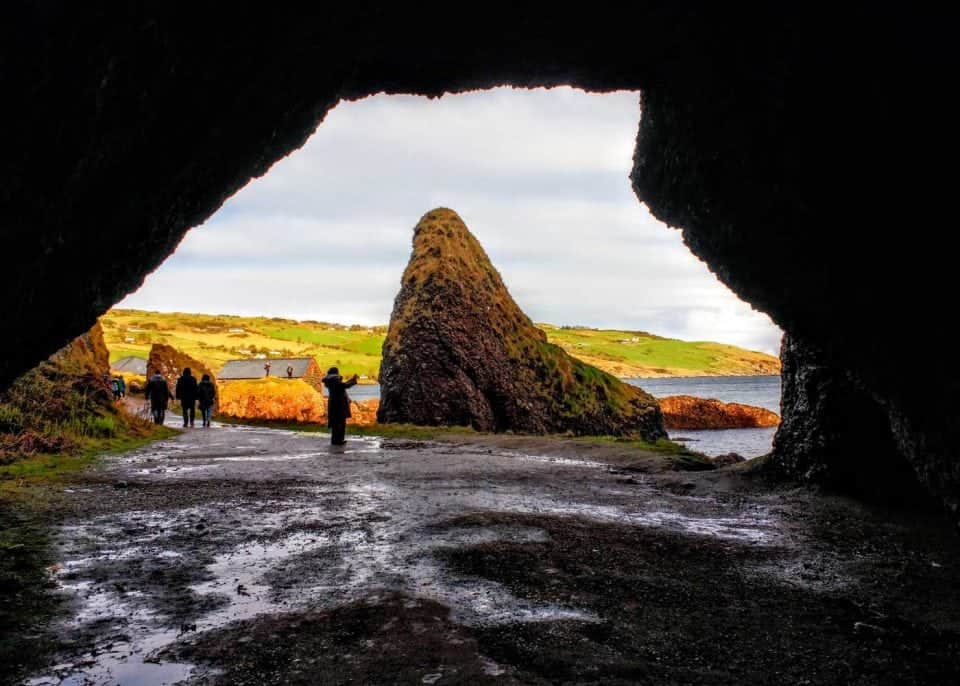
Don’t forget to take some apples or carrots for the welcoming goat called Johann who greets you by the statue of the last goat who fell victim to Foot and Mouth Disease that struck Ireland in 2001. These days it is Mirriam who welcomes you and your carrots.
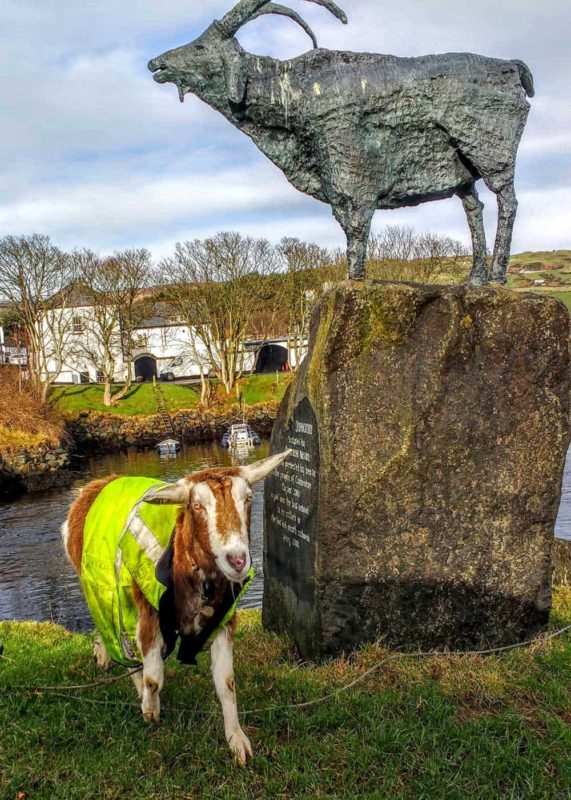
Fairy Hill of Tiveragh
If you can find the Ballybrack road you will find the fairy hill of Tiveragh. It is said there are good and bad fairies living on the hill and this can be seen by the well-groomed side and the rather rough-looking side of the mountain. There is a fairy tree halfway up and it is said that the fairies come out to play on Halloween or as it used to be known Samhain.
Fair Head
Standing on the cliffs at Fair Head and looking off to the west you can see the Republic whose lands in Donegal push further north than any other Irish county. Narrow lanes fenced by stone hand laid and locked into place with consummate skill. Mile-long puzzle pieces pulled from a land that couldn’t feed its own anything more than this. The Causeway Coastal Route will make poets out of all of us.
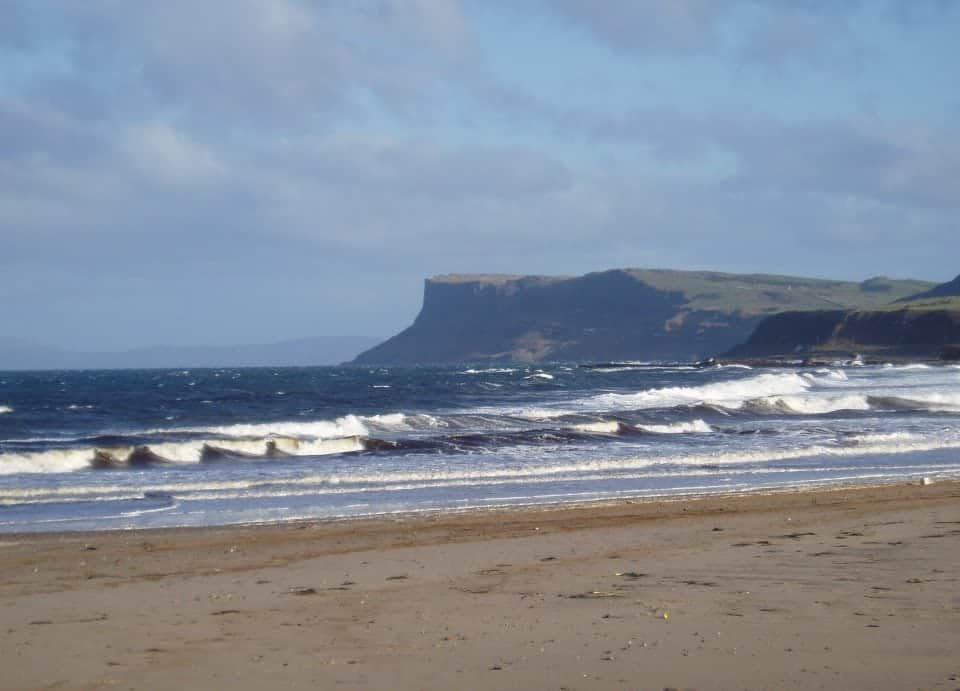
Torr Head Scenic Route
Rain rinsed skies meet a magical coastline as you move east into Torr Head and the Glens. Torr Head looks directly across the Irish Sea to the Mull of Kintyre. The tides of Torr Head are lethal but often it was easier to dare the crossing to Scotland as the valleys and mountains of the Glens behind were more treacherous than the tides. Follow the Torr road directly to Ballycastle.
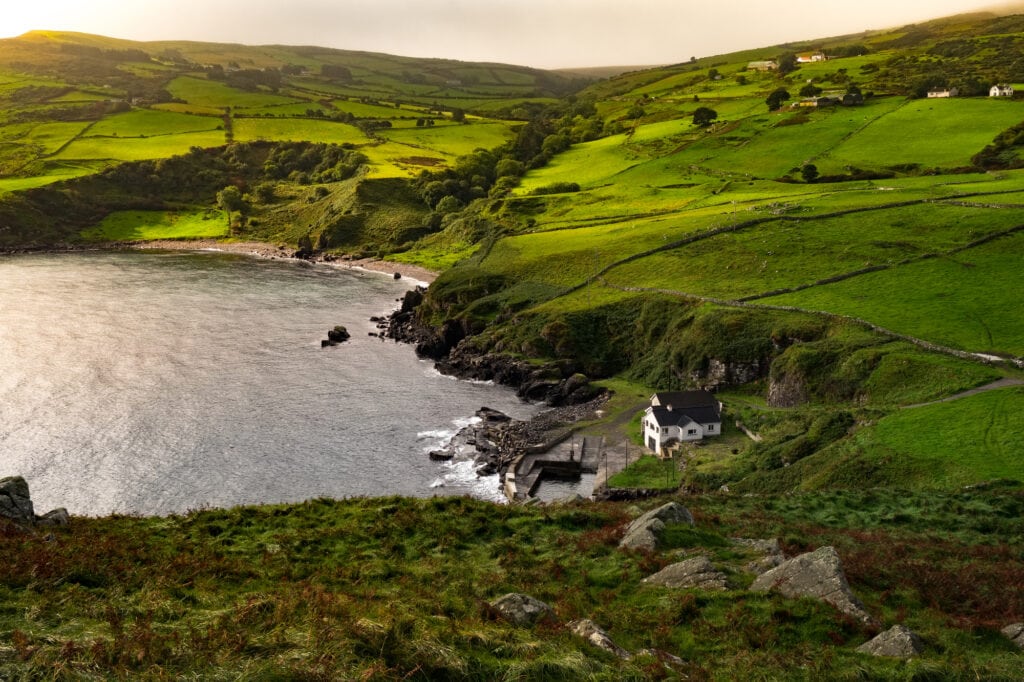
Ballycastle
Glenshesk opens out to the sea near Ballycastle with superb views of Rathlin Island and the Mull of Kintyre, which can be spotted on clear days. Glenshesk means the “glen of sedge” or reeds and it is a wild and untamed area. The drive from the Giant’s Causeway to Ballycastle is around 21 minutes.
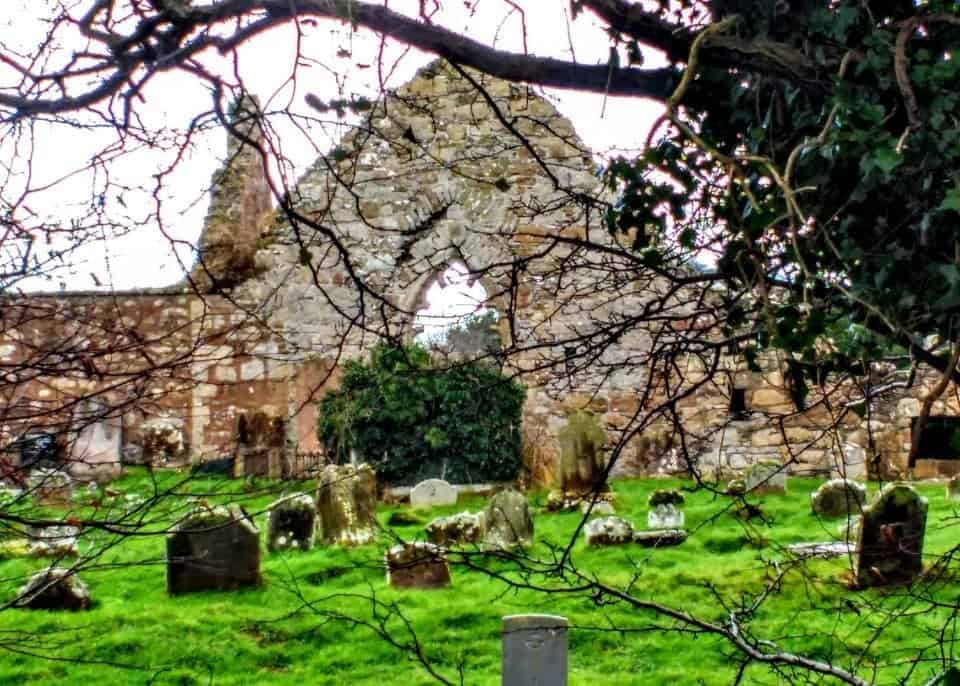
Bonamargy Friary
Just outside Ballycastle on the Whitepark Road lies the ruin of Bonamargy Friary, which is famous for its “Black Nun”. The nun wished to be buried at the entranceway of the chapel so that “she might be trodden under the feet of all who entered”. Her grave is marked by a round-holed cross the only one of its kind in Ireland.
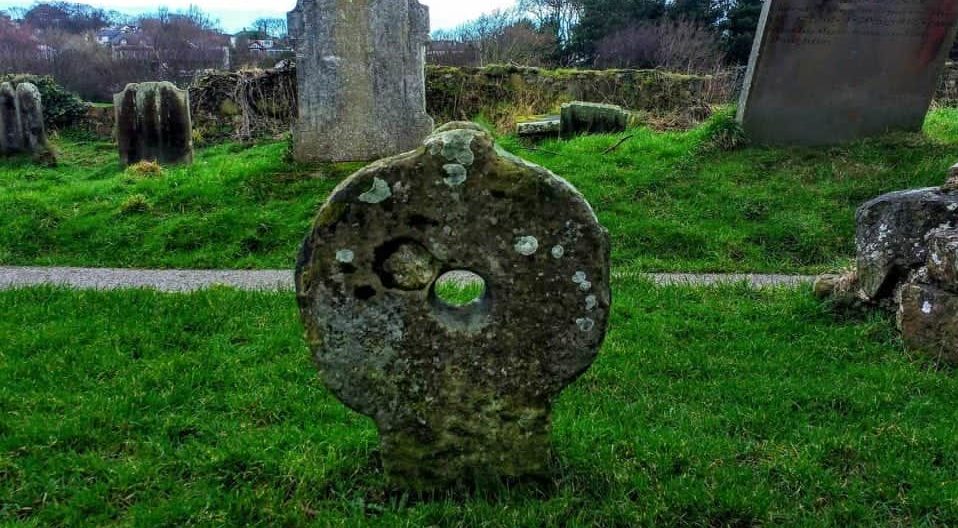
When you are in Ballycastle try and book the Manor House B&B for a stay. A lovely place and really well situated to tour both the small village and harbour area and easy to get to the harbour for a trip to Rathlin Island
If you are in Ballycastle and fancy trying some traditional Irish food you might want to take advantage of an Irish Feast Food tour while you are in the neighbourhood. I can’t say enough good things about the tours you can have a picnic on Rathlin Island or take a pub crawl or enjoy the best of Irish baked goods like scones, soda bread and more on this fabulous tour.
Rathlin Island
Rathlin Island is not an “official” part of the Causeway Coast tour nor is Bushmills Village but if you have time, you won’t want to miss either location.
Rathlin is most obviously an Island and has no cars (unless you are disabled) however, you can rent a bike or take one of the many tours to the bird sanctuary to see the puffins (of which I am obsessed lol). The Island has a pub so you can take a rest and it is a beautiful peaceful place to visit.
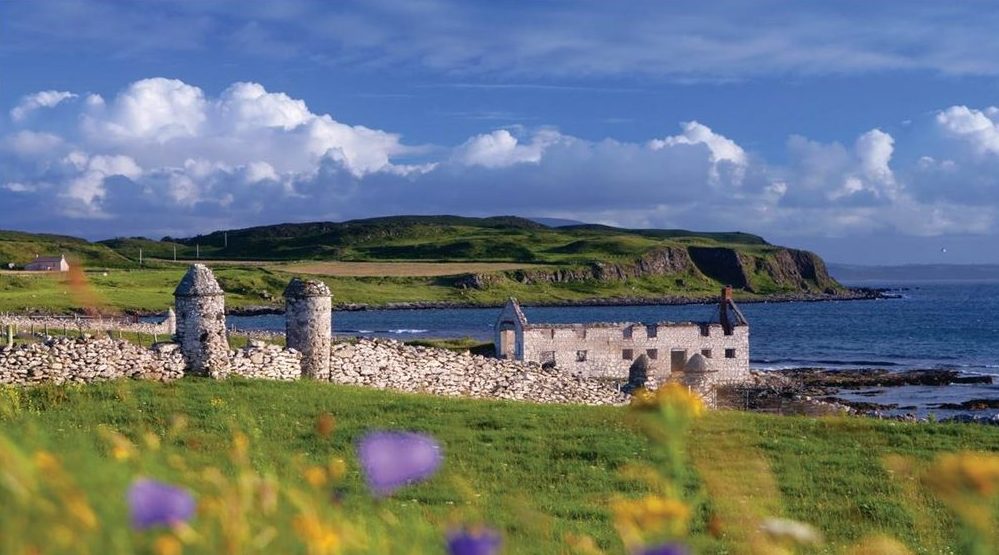
Bushmills Distillery and Village
Bushmills Village is, of course, the home of Bushmills the world-famous Irish whiskey. You can’t come to the Causeway Coast and not take a tour of the Village and the distillery.
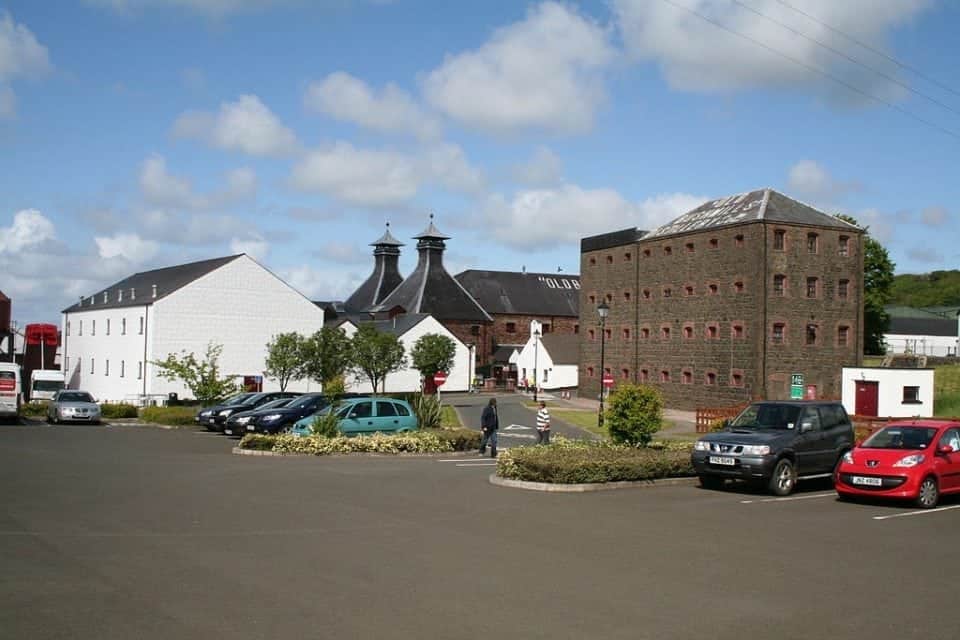
Bushmills is the closest village to the Giant’s Causeway and is approximately a 20-minute drive from Ballycastle. Set on the River Bush the village has the highest number of listed buildings in N. Ireland and you can visit the distillery.
The distillery is Ireland’s oldest licensed distillery blending whiskey for 400 years. Tours cost a mere £8 per adult and include tastings of the famous brew.
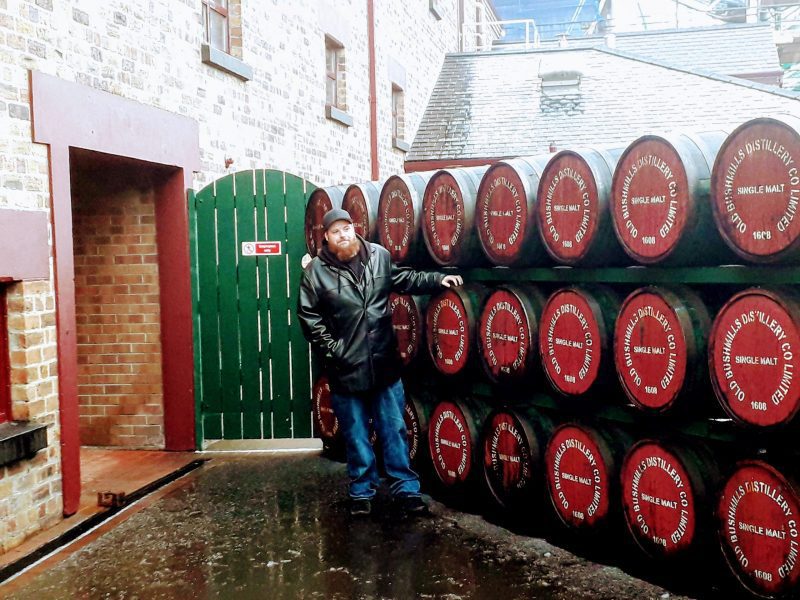
Carrick-a-Rede Rope Bridge
If you are ready to try the death-defying Carrick-a-Rede rope bridge experience where you cross an expanse of water over to the Island used by salmon fisherman for centuries you can head out from Bushmills where the drive will take around 15 minutes. There is a good-sized free parking lot at the site and a little cafe and gift shop to warm you up after your long walk.
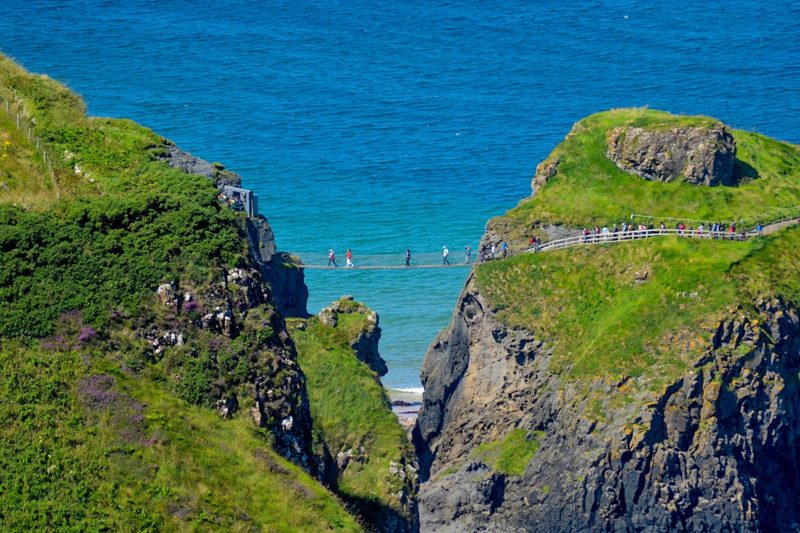
The walk to the bridge is around a 2.5 km round trip and tickets can only be purchased on the day you want to cross the bridge. The cost is £8 per adult and the ticket must be bought at the bridge site – which means get there early and get your ticket and don’t lose it. As I mentioned the walk is long there and back and quite rough going in spots there are also lots of stairs to go up and down. This isn’t for the faint of heart or someone whose mobility is challenged.
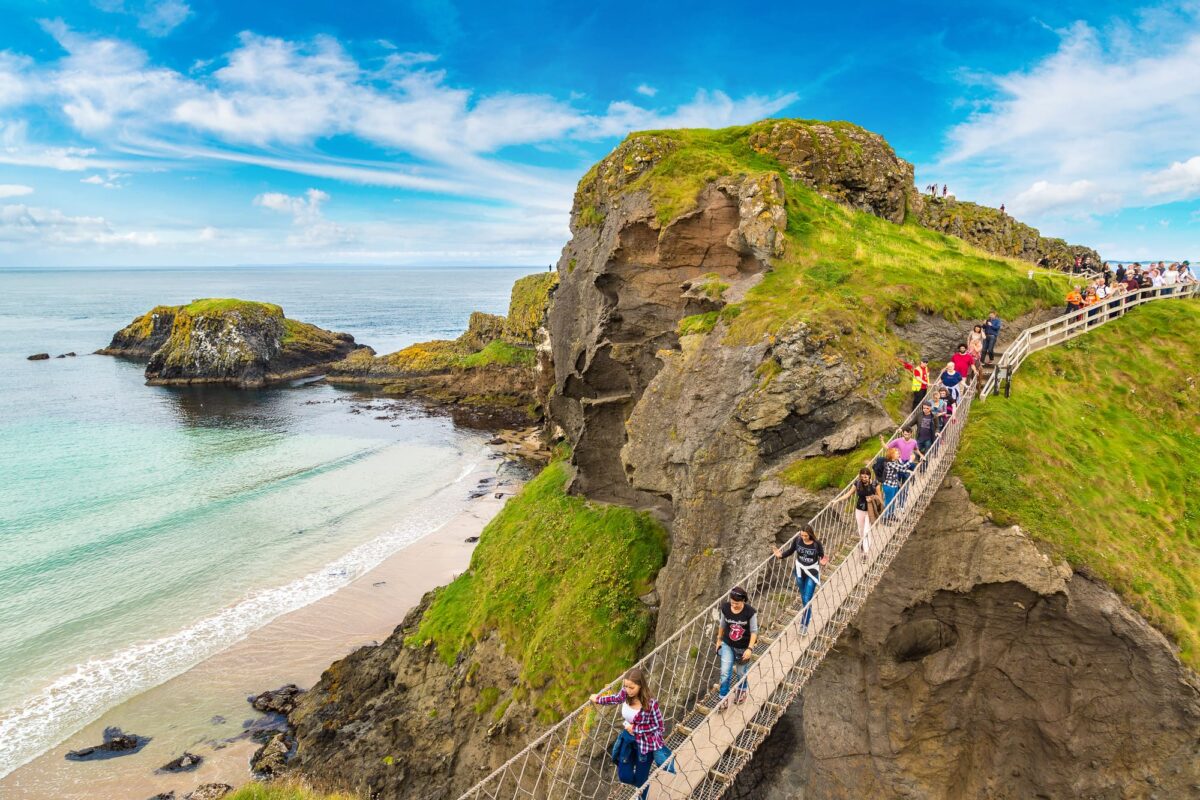
Dark Hedges
Technically not a part of the Causeway Coast Route and a short drive away from the coast – but one you shouldn’t miss if possible. The Dark Hedges has starred in the Game of Thrones show and are in some environmental danger due to their age and the over-tourism of the site. There is no driving the road anymore as it has caused damage to the area so you need to park and walk to the hedges.
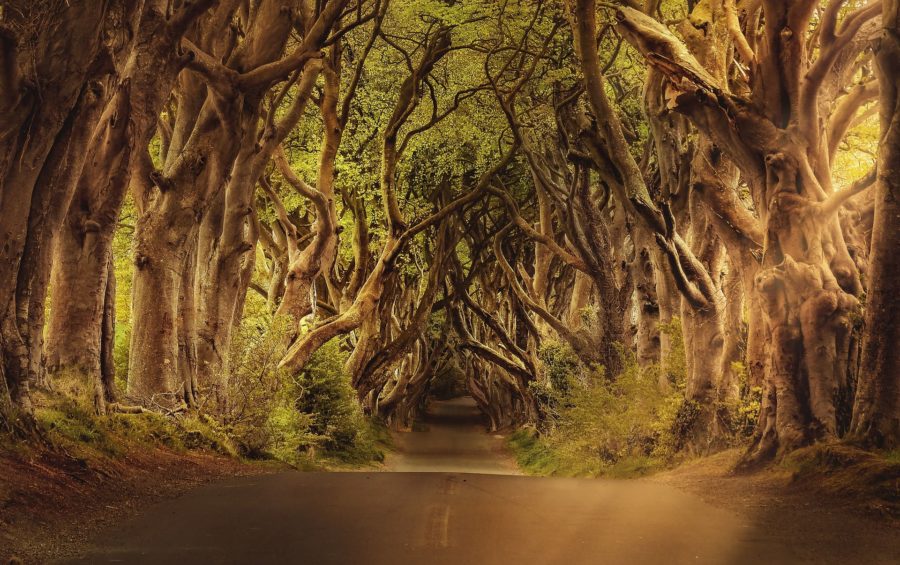
The Dark Hedges are located around a 15 minutes drive from Bushmills village or half an hour from the Giant’s Causeway.
The Stuart family planted the rows of beech trees designed to impress visitors as they approached the entrance to their mansion and today they remain the most photographed spot in N. Ireland.
Ballintoy
If you want to visit, Ballintoy Harbour (literally a 5-minute drive from Carrick-a-Rede) which has been featured in the Game of Thrones series you want to make sure you head for the Harbour and not the village of Ballintoy you will see the signs posted of the Causeway Road to both the harbour and the village. The harbour which looks out towards Boheeshane Bay, Sheep Island, Larry Bane Head, Rathlin Island and Scotland was built from limestone blocks quarried nearby and was used for shipping both limestone and salt to Scotland and England for building.
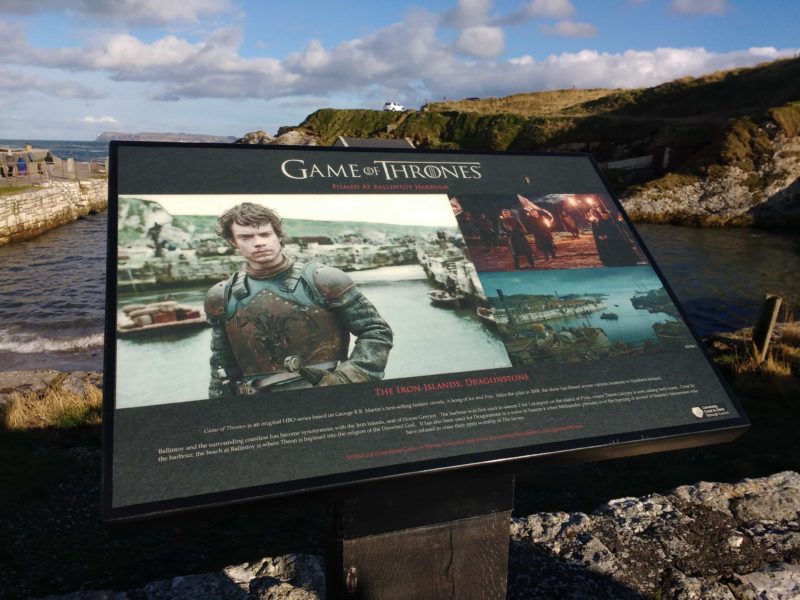
As a Game of Thrones location, Ballintoy was used as the town of Lordsport in the Isle of Pyke and the harbour stood in for most of the exterior Pyke shots and the Iron Islands. This is where Theon Greyjoy arrives back in the Iron Islands and meets his sister Yara and where his ship the Sea Bitch is anchored.
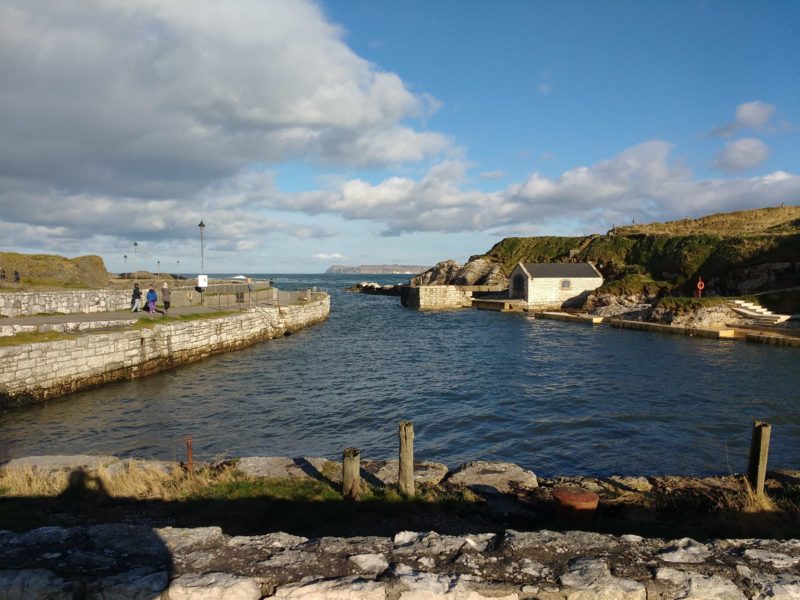
The Giant’s Causeway
The 15-minute drive down a damp slicked and quite likely foggy road (depending on the time of day and year) is made extraordinary by huge bushes edging the lanes. As you stop to let the sheep cross the road, you realize these are ten feet tall fuchsia trees dropping their flowers and carpeting the roadsides.
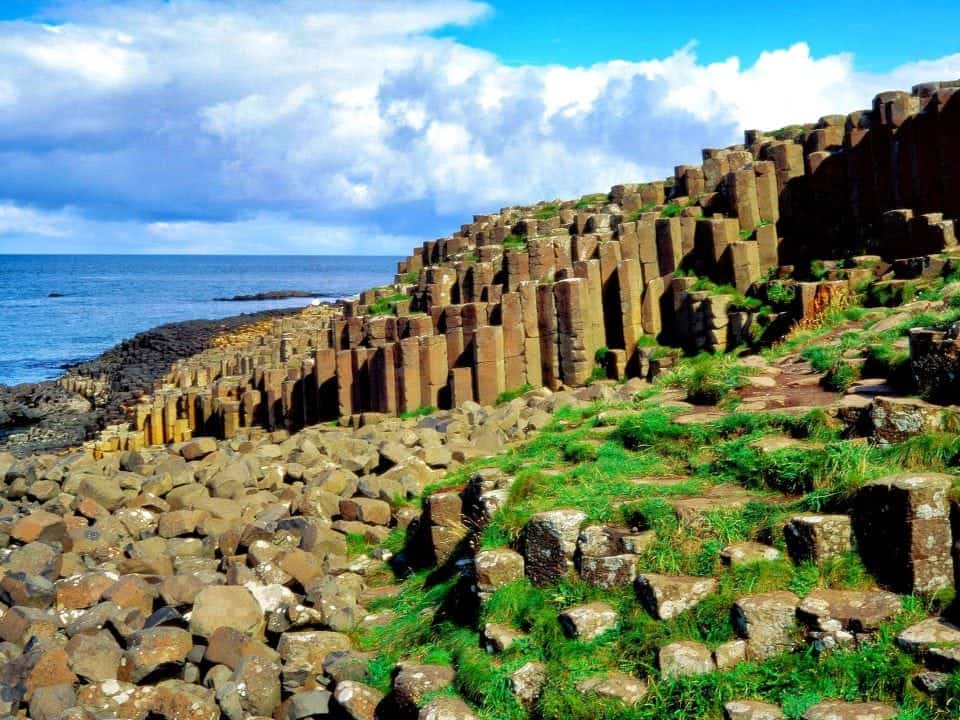
The Giant’s Causeway is a UNESCO World Heritage site since 1986 and was formed around 60 million years ago and is of course the main focus of visitors to the Northern Ireland causeway coast. The Giant’s Causeway lies at the foot of the basalt cliffs along the sea coast on the edge of the Antrim plateau in Northern Ireland. It is made up of some 40,000 massive black basalt columns sticking out of the sea.
The Giant’s Causeway is one of those incredible natural sites that simply take your breath away. Formed millions of years ago the basalt columns are mainly hexagonal though there are some with up to eight sides. Some of the formations have names such as the Chimney Stacks, The Harp, The Organ and the Camel’s Hump.
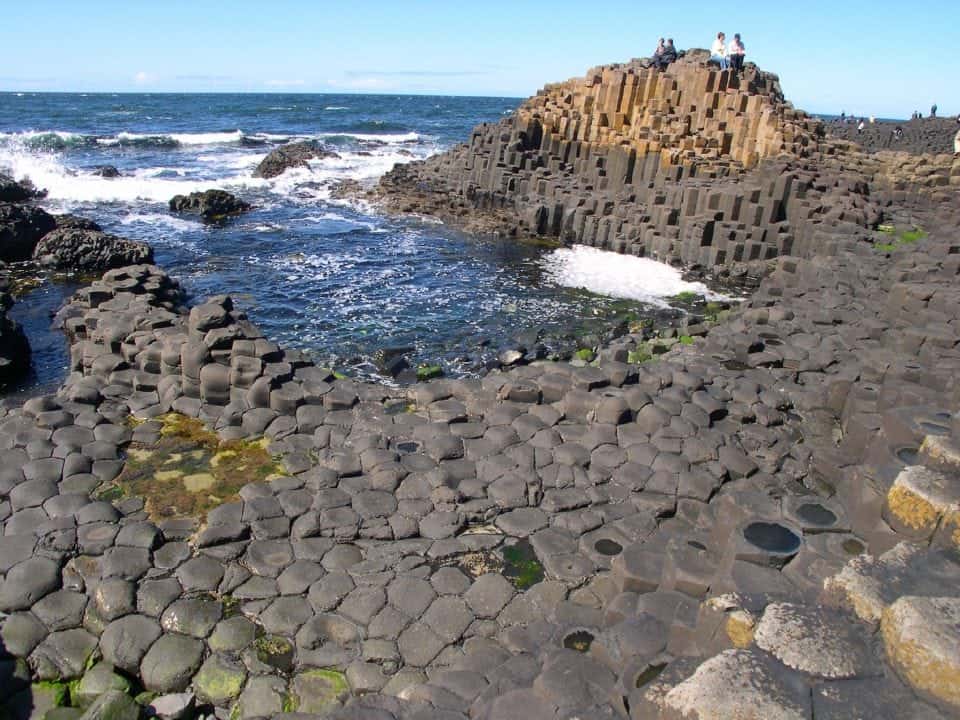
The truly sad thing about the Giant’s Causeway site is the controversy that is being caused by the National Trust’s policies. The site is FREE for all to visit, however, the National Trust employees are telling visitors that they must pay £12.00 per person in the vehicle to park the car and enter the Causeway.
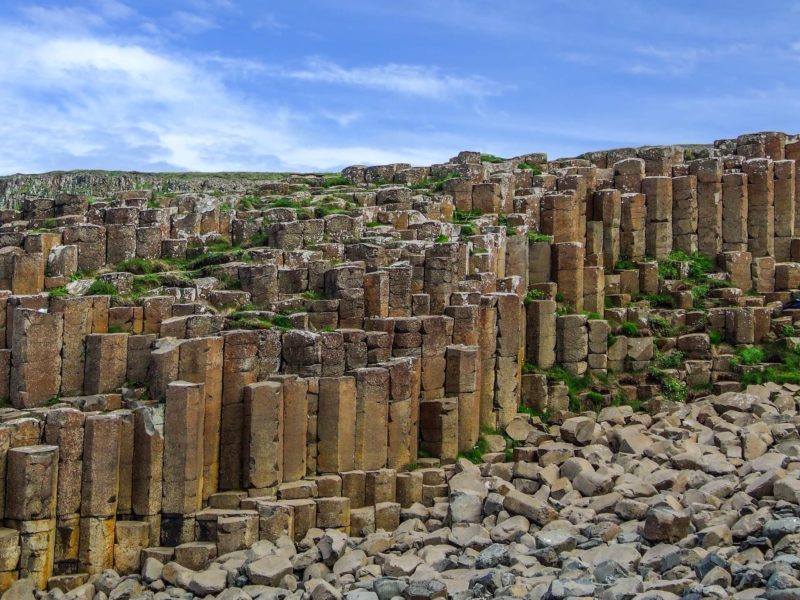
This is absolutely not true the Causeway is free for all to enter and view you just don’t park in the National Trust lot or use the visitor’s centre. Simply park in the nearby mini railroad parking lot for a fiver or have lunch at the local pub nearby and park for free. When you leave the pub go through the tunnel you will see to the right of the pub entrance and you will end up where the shuttle buses will pick you up.
An absolutely brilliant way to see the Giant’s Causeway is at sunrise take a look at this piece by Corinne Meeting The Sunrise From The Hexagonal Stones Of The Giant’s Causeway.
Visiting Dunluce Castle
Dunluce looks like it should be haunted. Dunluce Castle is a medieval Irish castle that stands atop a dramatic basalt cliff jutting out from the sea at the very edge of the Northern Irish Causeway Coast, it sits still and black amidst the green. The Sea of Moyle crashes below it and can be seen through grills set in the stone to protect tourists from falling onto the rocks below.
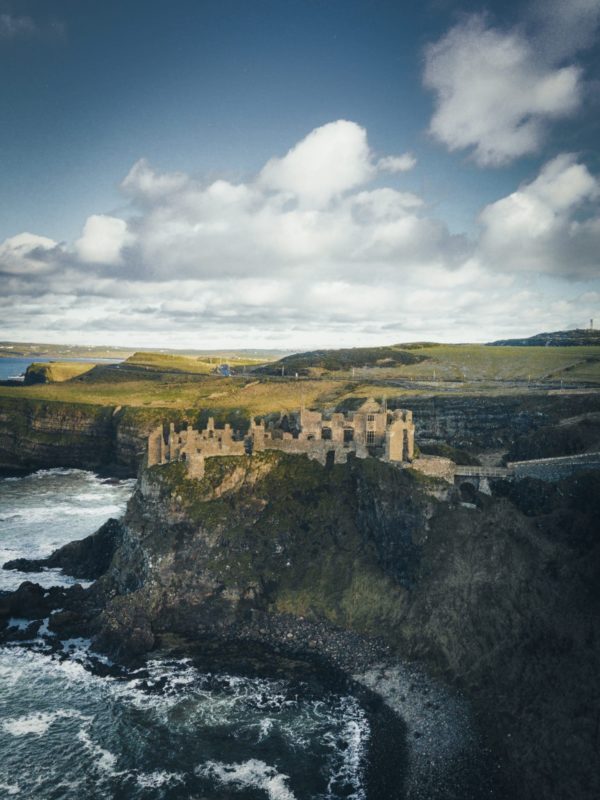
Historians and Archaeologists are not buying the legend of the kitchens falling into the sea during a storm. Research and paintings of the castle from the 18th and 19th centuries show the castle was completely whole with kitchens during the time frame it is said that the building started to collapse.
The McQuillans, as part of the Ulster-Scots settlements, originally built the castle in 1500. They came to Ireland from Scotland during the 1200s as paid mercenaries and they built their castle 200 years after their arrival.
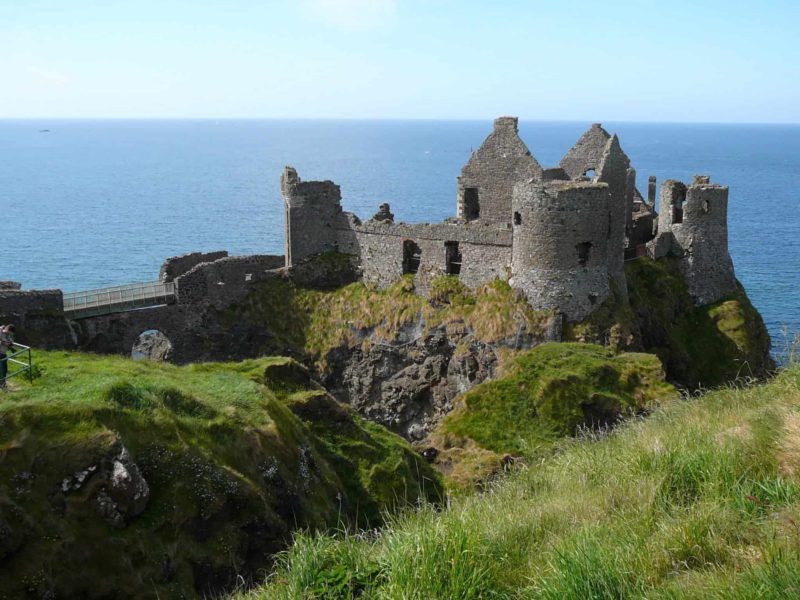
- The McQuillans owned the castle for around 55 years held the MacDonnells, who came over from Islay in 1554, took the castle for about 55 years before it. They still own the castle, but now live in Glenarm.
- The Marchioness of Londonderry’s heirs left the castle to Winston Churchill along with the Estate of Carnlough.
- Archaeologists in the past 5 years or so have uncovered a town across from where the Castle stands which was of course known as Dunluce. It was designed to rival Coleraine. Unfortunately, in 1642 the Irish rebels attempting to capture Dunluce Castle and losing set fire to the town and burnt it down.
- Excavations have discovered a cobbled street stretching through the town towards the castle, with a blacksmith’s forge. They have also found coins from the reign of Elizabeth 1 and Charles 1 as well as bone combs, dress fastenings, gaming pieces, wine glass stems, a bronze tuning pin for a harp and other household items.
- The dig uncovered a Scottish merchant’s house, built in the first two decades of the 17th century, fronting onto the cobbled streets. The walls survive to waist height with plastered walls, an internal privy and a fireplace. The town also held a courthouse and a dungeon.
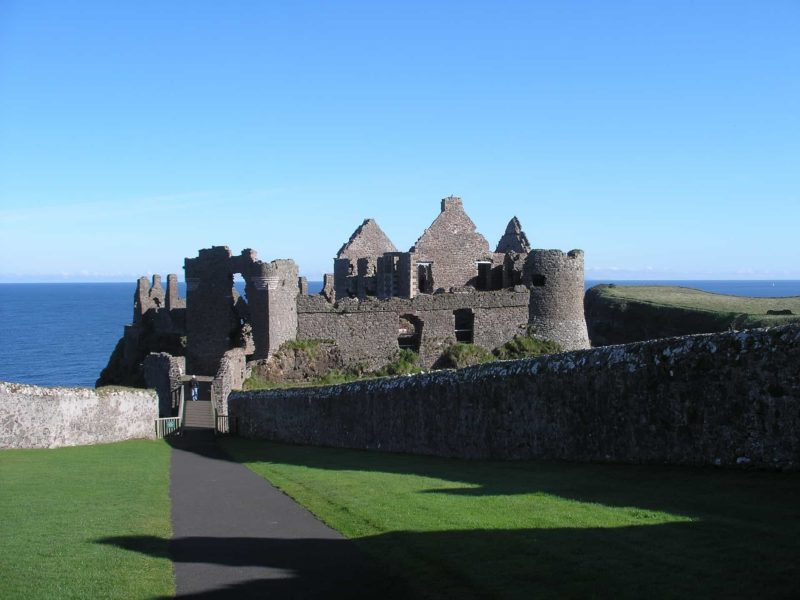
Portrush
Belfast to Portrush via coastal route will be around a 2.5-hour drive. Portrush is a typical Irish seaside village. Ice cream stalls, people-watching cafes, fishing off the rocks and good old-fashioned seaside fun. The town is the heart of surfing in N. Ireland and has three beautiful sandy beaches and one of the world’s best golf courses, the Royal Portrush, which is a links course.
For the kids, there is Barry’s Amusements, which is the largest fun park in N. Ireland. There are bingo, slots, penny arcades lots of shopping and touristy beachy gifts, cafes, restaurants and pubs to grab some food.
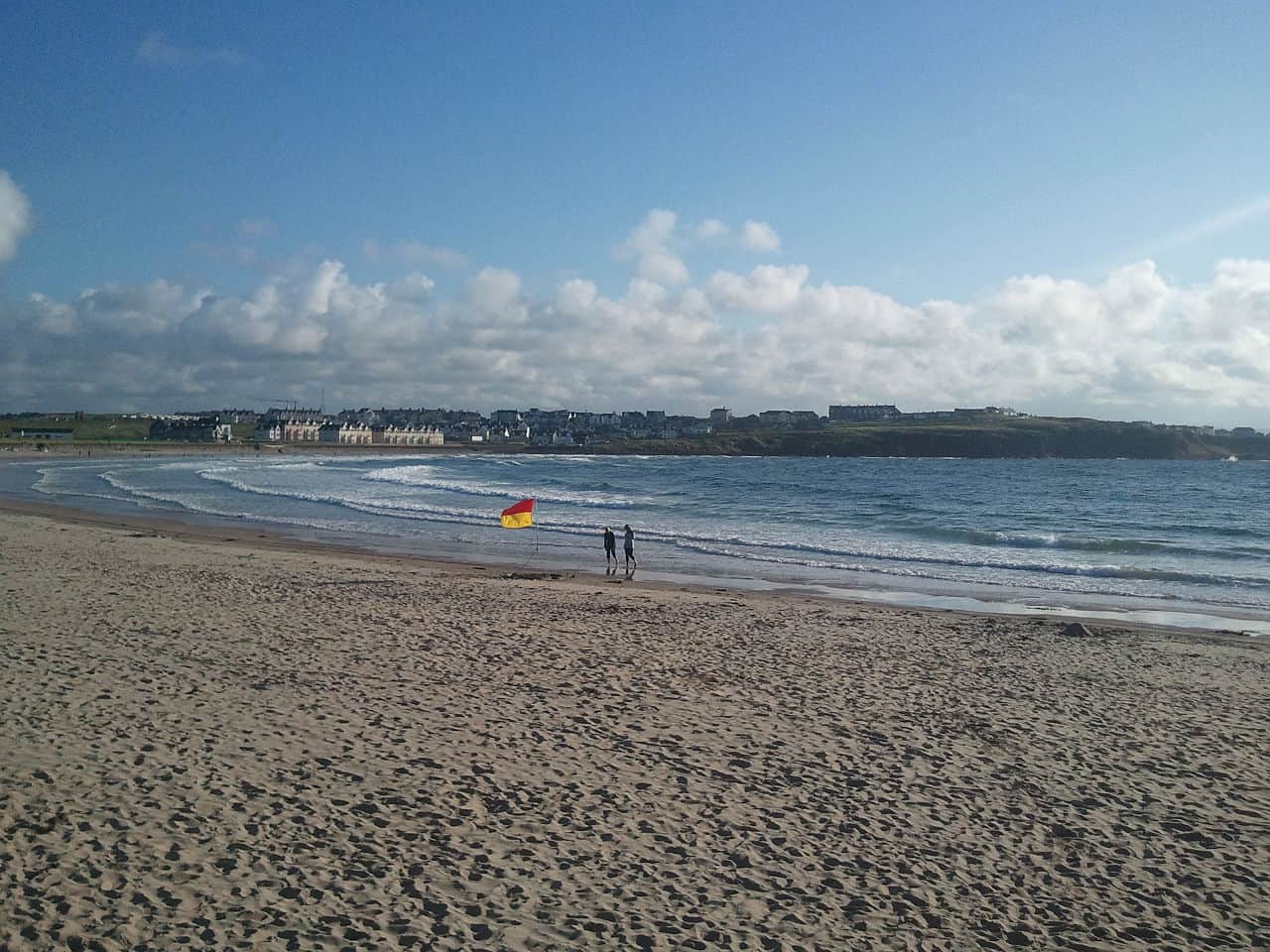
Portstewart
Portstewart is around 10 minutes or less from Portrush. Another traditional Irish seaside village Portstewart is the largest town on the route and it’s the only one that is in the County of Derry (Londonderry). Like Portstewart, there are plenty of seaside things to do, with a blue flag beach. Portstewart is one of the best surfing beaches and there are plenty of watersports to choose from.
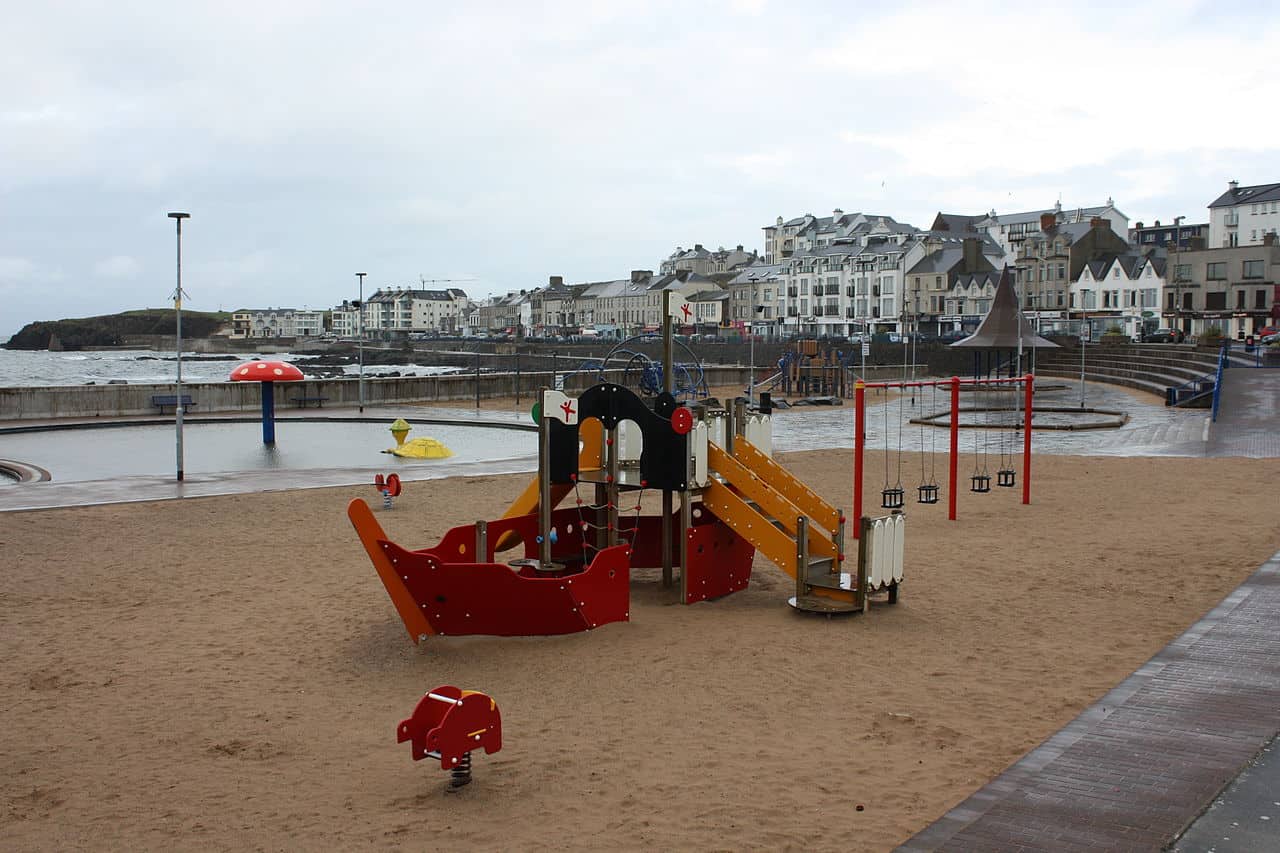
Benone
Benone Beach is a gorgeous blue flag beach that has no rocks, seaweed or shingle to interrupt your run into the sea. The sand dunes at Benone are impressive and support a wide variety of birdlife in the area.
Take a heritage walking tour around the town and marvel at the lovely 19th-century buildings including the railway station church, and of course, the “Twelve Apostles” a row of tiny houses sitting above the beach.
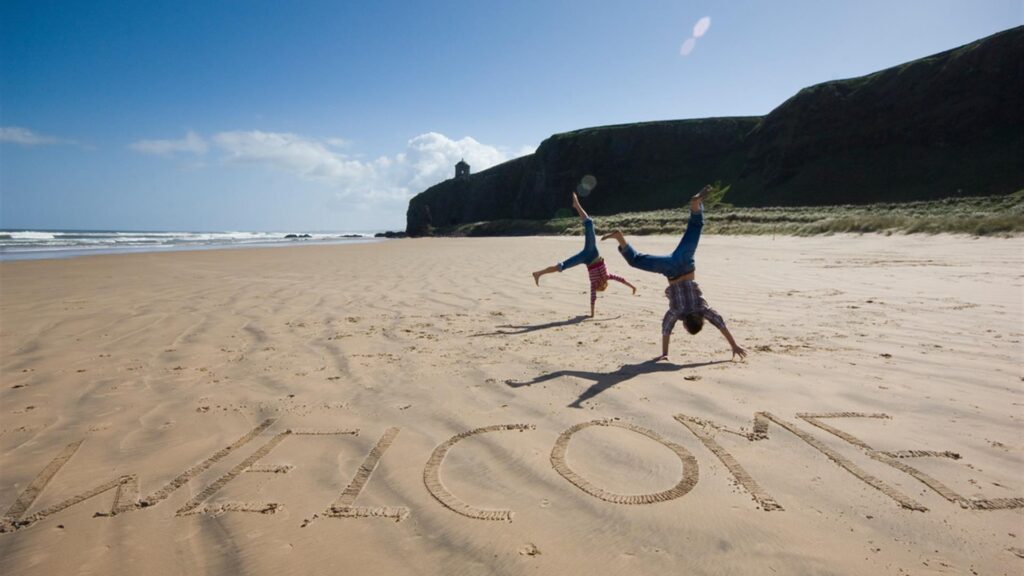
Castlerock
Driving east it will take you around 25 minutes to get to Castlerock, which is within the Binevenagh Area of Outstanding Natural Beauty. It is a small village with a brilliant golf course, local shops and tearooms and of course nearby is Benone.
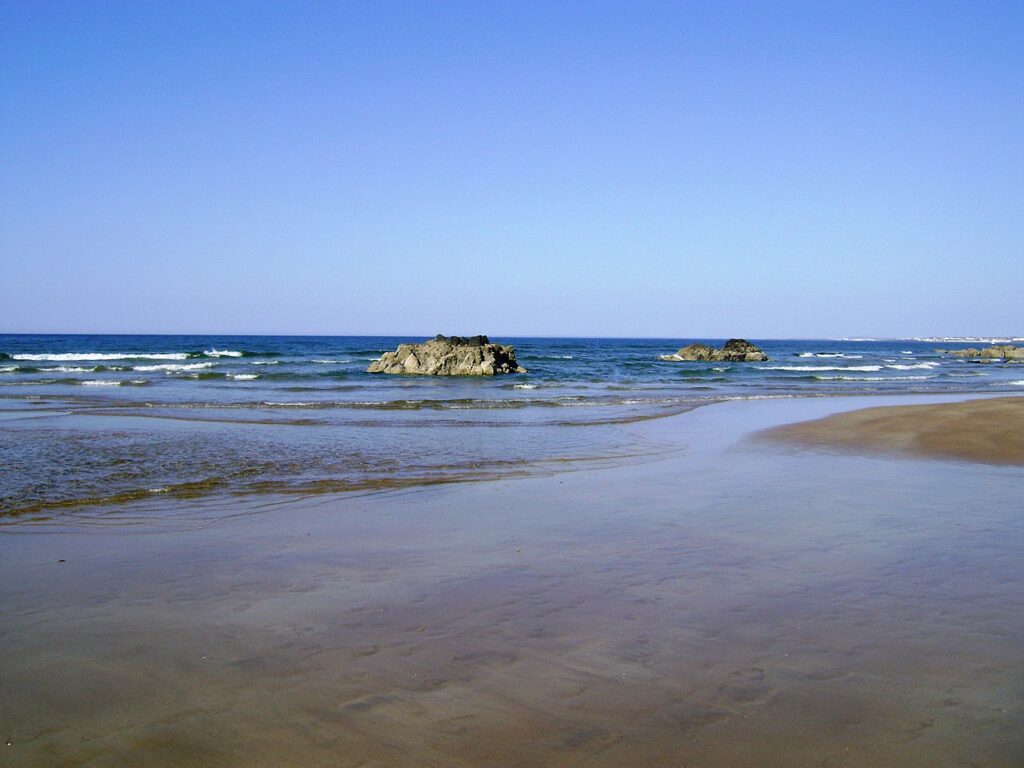
As you drive to Castlerock you may stumble across Hazlett House, which is a simply stunning thatched cottage from the 17th century. Owned by the National Trust you can tour the cottage and the grounds and experience one of N. Ireland’s oldest buildings.
Castlerock starts where the River Bann meets the sea, 5 miles west of Coleraine on the way towards Limavady and Londonderry It is surrounded by nature in many forms and is within the Benevenagh Area of Outstanding Natural Beauty (AONB). There is a small selection of local shops, tea shops, restaurants, pubs, a Village Green and a Community Centre in the heart of the town proper. The excellent championship golf course and the exceptional Blue Flag beaches at Castlerock, Downhill, Benone bring flocks of visitors to the town.
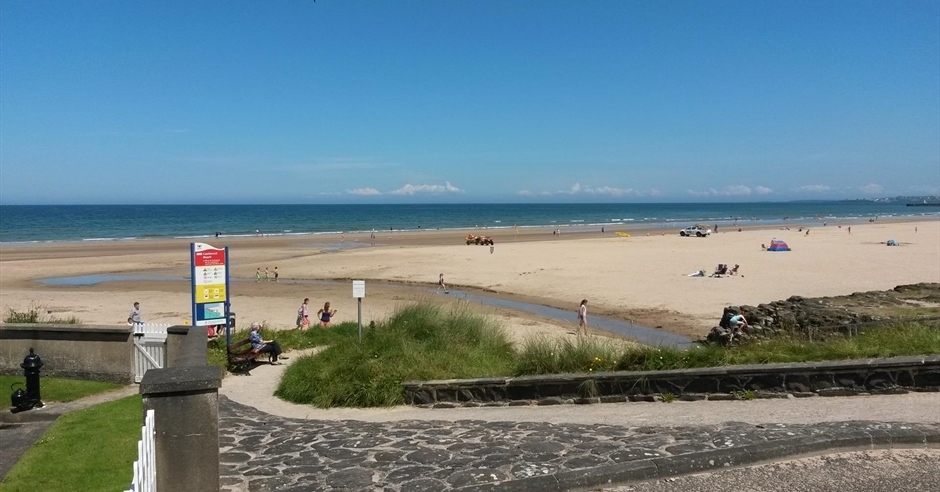
Binevenagh Mountain
The Binevenagh Mountain in County Derry was where the Dothraki horde captured Daenerys after Drogon rescued her from the attack on Daznak’s Pit in season 5. It’s also where Jorah – in what would be considered a minor miracle – found the ring she dropped as a clue to where she could be found.
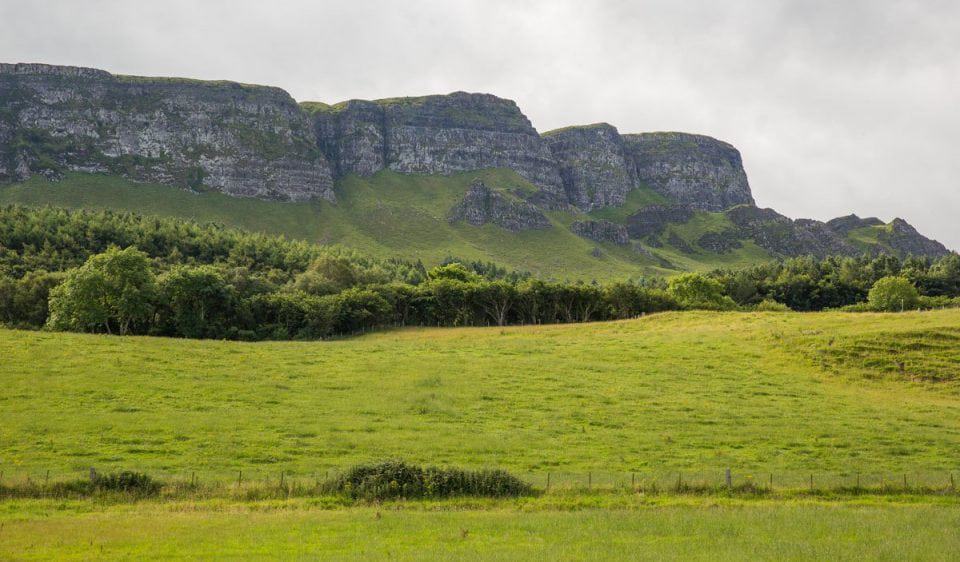
Mussenden Temple & Downhill Demesne
Downhill Strand which is a 25-minute ride from the Mountain, stood in for the windswept shore of Dragonstone when Stannis was there. This is where Melisandre sacrificed statues of the seven gods of Westeros and Stannis launched his ill-fated voyage to Blackwater Bay.
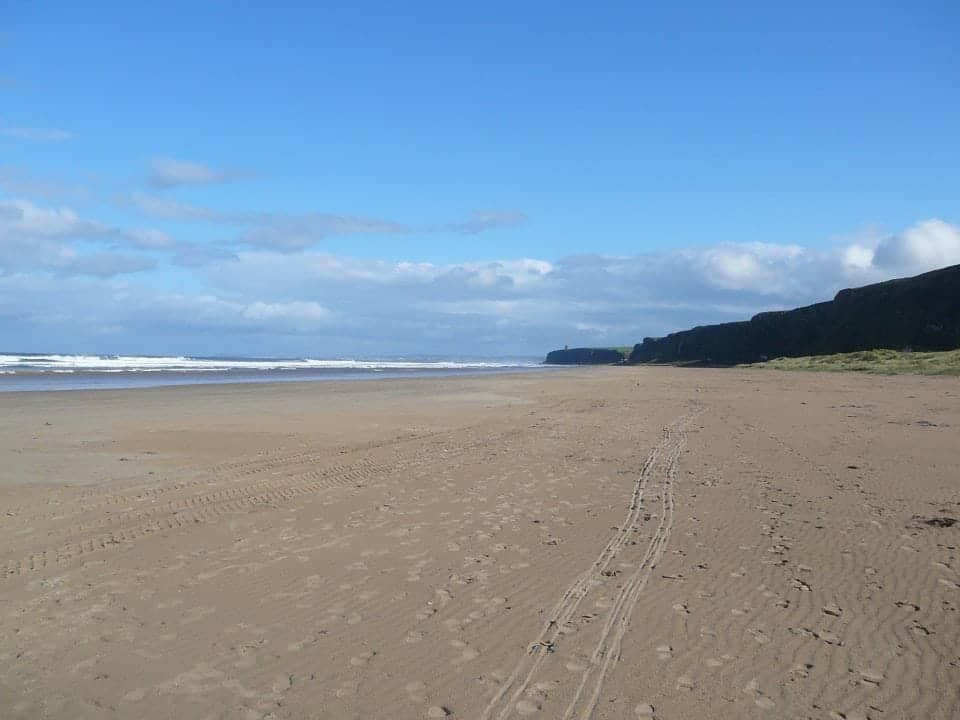
Downhill Strand is a fabulous beach and if you look up you will see the Mussenden Temple, which was built, as a replica of the Temple of Vesta in Italy.
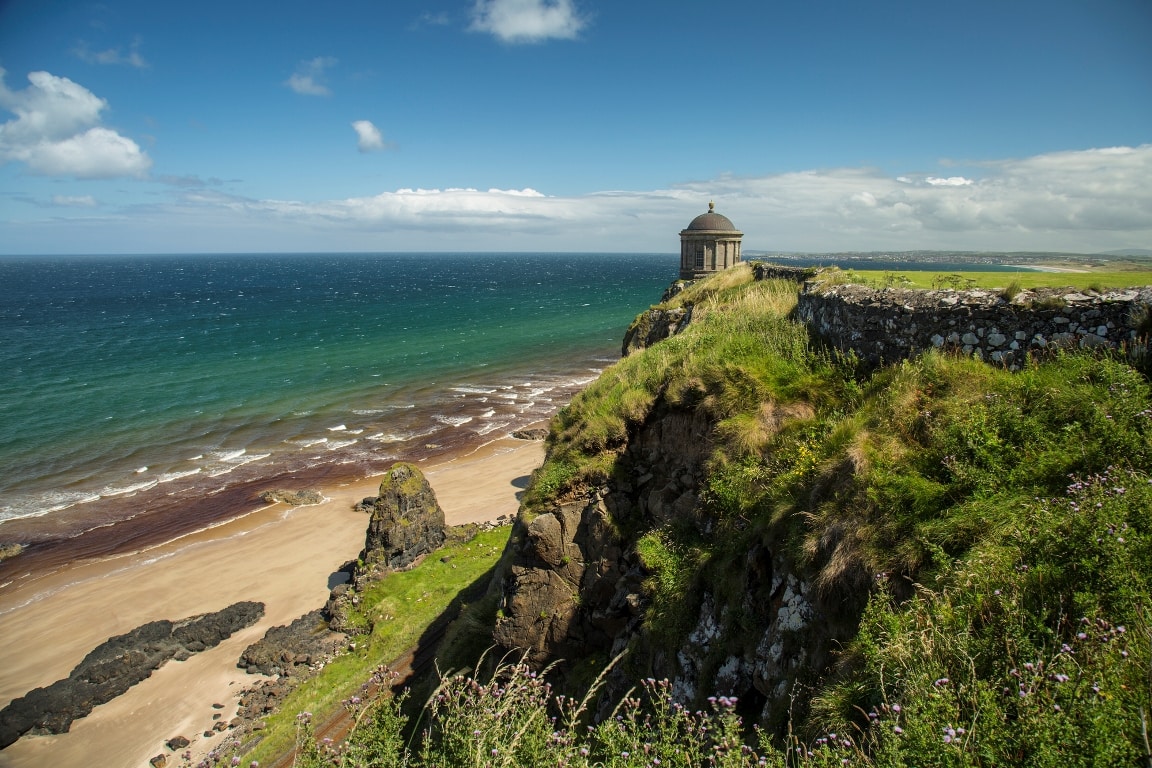
Derry (Londonderry)
The final stop on our Causeway Coast Itinerary is Londonderry or Derry depending on which side of the name you come down on. This drive will take about an hour from Downhill Strand.
Derry is the second biggest city in Northern Ireland borders Donegal and has close ties to the County. Its name Derry comes from the Irish word Daire which means oak forest. Derry is the only remaining intact walled city in Ireland. The Old City, which is walled, is on the west bank of the Foyle River and is spanned by two bridges for vehicles and the pedestrian bridge named the Peace Bridge.
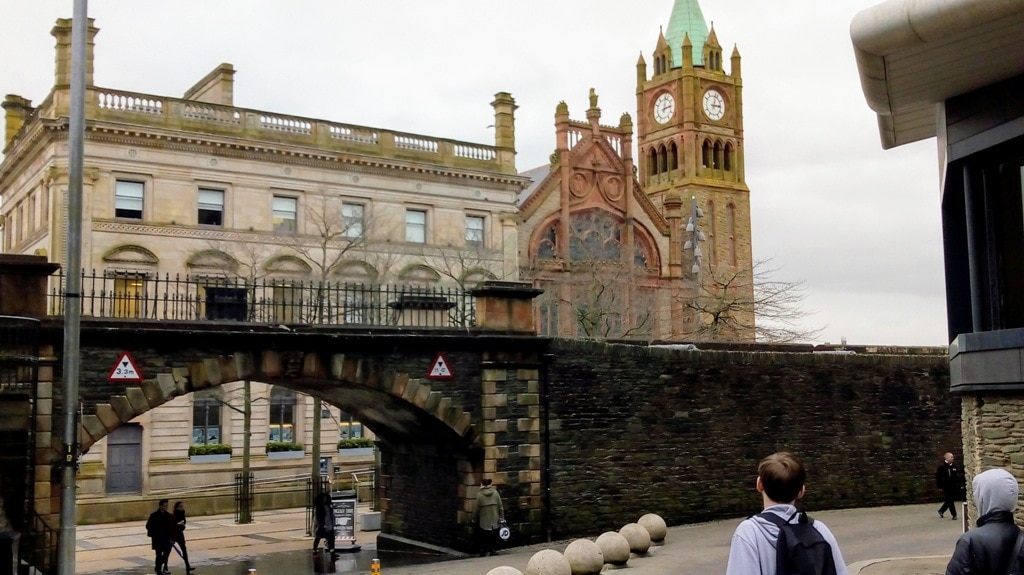
Derry is a fascinating place and well worth a day or so, it is an easily walkable city with lots to do and see from the ancient city walls to the Peace Bridge, Bogside and its mural history of the Troubles to great pubs and lots more.
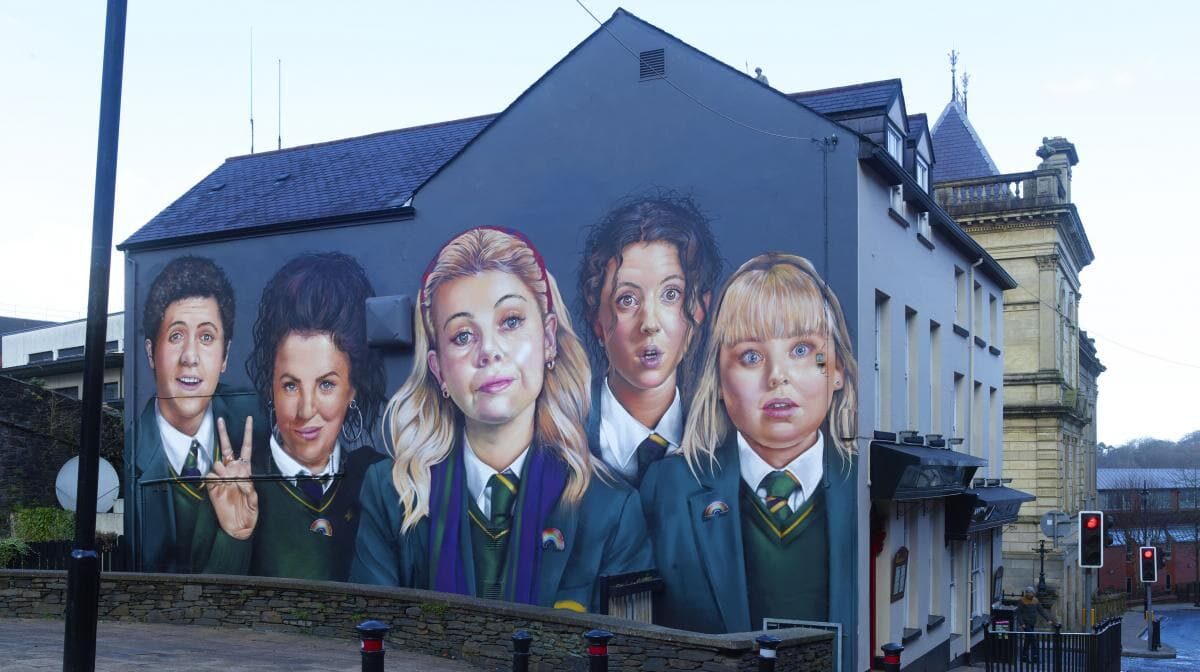
If you are lucky you may even get to see some puffins on the Causeway coastal drive. Ireland is a land of many contrasts and there is much to see and do. Do you have a favourite spot on the Causeway Coast?
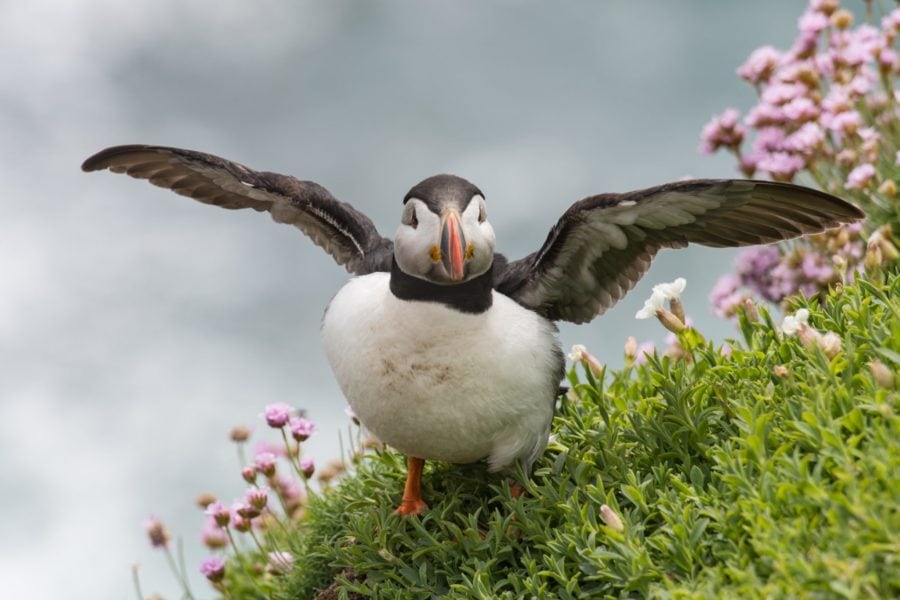
Where to stay on Causeway Coastal Route
- The Bushmills Inn, Bushmills: Located in the heart of the village of Bushmills, this award-winning boutique hotel offers luxurious accommodations with a traditional Irish ambiance. It’s close to the Giant’s Causeway and features a cozy bar and restaurant serving delicious local cuisine.
- Ballygally Castle Hotel, Ballygally: Situated on the coast near Larne, Ballygally Castle Hotel is a unique 17th-century castle hotel with stunning views of the sea. It offers elegant rooms, fine dining options, and a charming atmosphere.
- The Culloden Estate and Spa, Belfast: This 5-star hotel is set in a beautiful 19th-century mansion overlooking Belfast Lough. It features luxurious rooms, a renowned spa, and excellent dining options. The Culloden Estate and Spa provides a perfect blend of tranquility and convenience, being close to Belfast and the Causeway Coastal Route.
- The Galgorm Spa & Golf Resort, Ballymena: Situated in a picturesque estate near Ballymena, the Galgorm Spa & Golf Resort is a luxurious retreat. It offers a world-class spa, stunning grounds, and an 18-hole championship golf course. The hotel’s elegant rooms and exceptional dining options make it a top choice for relaxation and indulgence.
- Roe Park Resort, Limavady: This beautiful resort is located on the outskirts of Limavady and offers a tranquil setting amidst parkland and gardens. The Roe Park Resort features spacious rooms, a golf course, a spa, and a variety of dining options. It’s a great choice for those seeking a peaceful retreat while exploring the Causeway Coastal Route.
- The Merchant Hotel, Belfast: Housed in a historic building in Belfast’s Cathedral Quarter, The Merchant Hotel is a luxurious 5-star hotel known for its opulence and elegance. It offers beautifully appointed rooms, a rooftop gym, a spa, and a range of dining options, including a stunning cocktail bar.
These hotels provide a blend of luxury, comfort, and proximity to the stunning attractions along the Causeway Coastal Route. It’s advisable to book in advance, especially during peak travel seasons, to secure your desired accommodation.
As you conclude your trip planning for Northern Ireland’s causeway coastal route, make sure to map out the stops along the coast that you want to visit. This causeway coastal route guide can help you navigate the best attractions and viewpoints along the way. From the legend of the Giant’s Causeway to the Giant’s causeway visitor center, there is plenty to see and do on your causeway coast road trip.
When you get to the causeway, be sure to take the time to explore both the famous geological site and the surrounding area. Northern Ireland’s causeway offers breathtaking views and unique experiences that you won’t want to miss. Consider taking a detour along the Torr head scenic route for even more stunning scenery.
Whether you’re interested in history, nature, or simply taking in the beauty of the Irish coastline, Northern Ireland’s causeway coastal route offers something for everyone.
You might also like
44 of the best things to do in Belfast
101 Landmarks in Northern Ireland

